Impact of HR Practices on Employee Retention in Food and Beverage Industry
VerifiedAdded on 2023/06/10
|24
|6474
|111
AI Summary
This research aims to find out the major reasons due to which employees leave the organizations in the food and beverage industry and develop effective HR practices to diminish the attrition rate. The research questions, objectives, hypothesis, and literature review are discussed in detail. The effective HR practices such as effective communication, de-centralization, and career development are highlighted.
Contribute Materials
Your contribution can guide someone’s learning journey. Share your
documents today.

Running head: RESEARCH PROJECT
Research Project
The impact of HR practices on the retention of employees - Evidence from Food and Beverage
industry
Name of the Student
Name of the University
Author Note
Research Project
The impact of HR practices on the retention of employees - Evidence from Food and Beverage
industry
Name of the Student
Name of the University
Author Note
Secure Best Marks with AI Grader
Need help grading? Try our AI Grader for instant feedback on your assignments.
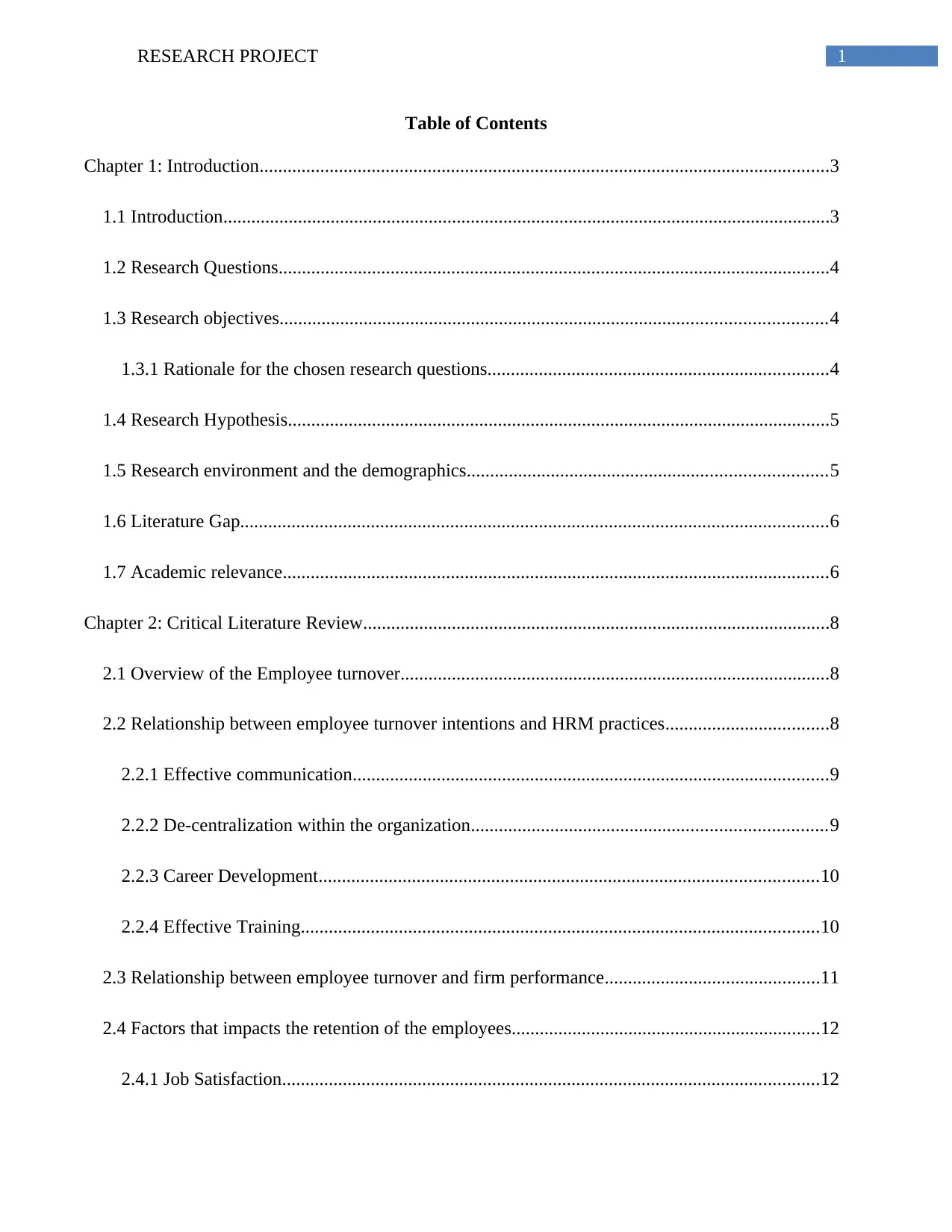
1RESEARCH PROJECT
Table of Contents
Chapter 1: Introduction..........................................................................................................................3
1.1 Introduction..................................................................................................................................3
1.2 Research Questions......................................................................................................................4
1.3 Research objectives.....................................................................................................................4
1.3.1 Rationale for the chosen research questions.........................................................................4
1.4 Research Hypothesis....................................................................................................................5
1.5 Research environment and the demographics.............................................................................5
1.6 Literature Gap..............................................................................................................................6
1.7 Academic relevance.....................................................................................................................6
Chapter 2: Critical Literature Review....................................................................................................8
2.1 Overview of the Employee turnover............................................................................................8
2.2 Relationship between employee turnover intentions and HRM practices...................................8
2.2.1 Effective communication......................................................................................................9
2.2.2 De-centralization within the organization............................................................................9
2.2.3 Career Development...........................................................................................................10
2.2.4 Effective Training...............................................................................................................10
2.3 Relationship between employee turnover and firm performance..............................................11
2.4 Factors that impacts the retention of the employees..................................................................12
2.4.1 Job Satisfaction...................................................................................................................12
Table of Contents
Chapter 1: Introduction..........................................................................................................................3
1.1 Introduction..................................................................................................................................3
1.2 Research Questions......................................................................................................................4
1.3 Research objectives.....................................................................................................................4
1.3.1 Rationale for the chosen research questions.........................................................................4
1.4 Research Hypothesis....................................................................................................................5
1.5 Research environment and the demographics.............................................................................5
1.6 Literature Gap..............................................................................................................................6
1.7 Academic relevance.....................................................................................................................6
Chapter 2: Critical Literature Review....................................................................................................8
2.1 Overview of the Employee turnover............................................................................................8
2.2 Relationship between employee turnover intentions and HRM practices...................................8
2.2.1 Effective communication......................................................................................................9
2.2.2 De-centralization within the organization............................................................................9
2.2.3 Career Development...........................................................................................................10
2.2.4 Effective Training...............................................................................................................10
2.3 Relationship between employee turnover and firm performance..............................................11
2.4 Factors that impacts the retention of the employees..................................................................12
2.4.1 Job Satisfaction...................................................................................................................12
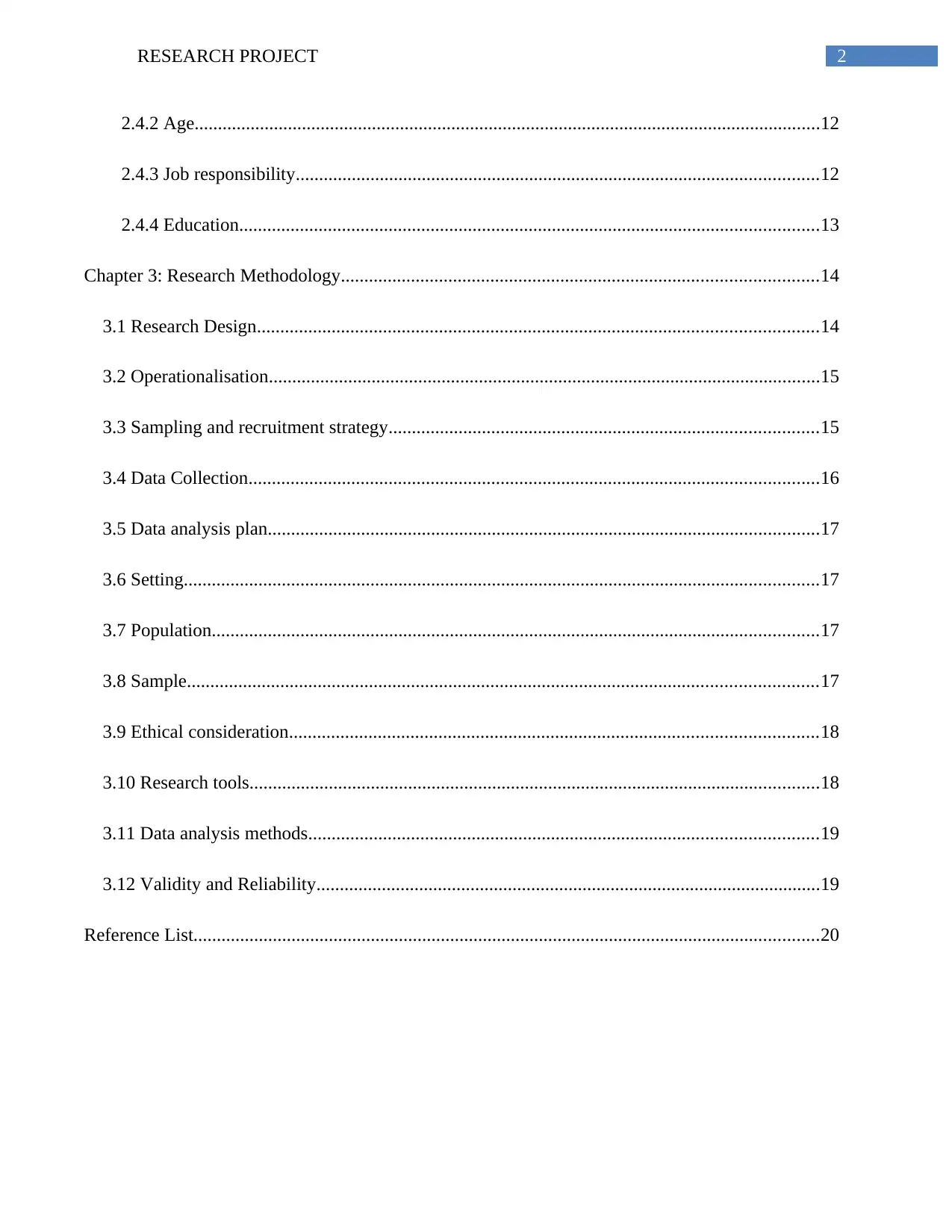
2RESEARCH PROJECT
2.4.2 Age......................................................................................................................................12
2.4.3 Job responsibility................................................................................................................12
2.4.4 Education............................................................................................................................13
Chapter 3: Research Methodology......................................................................................................14
3.1 Research Design........................................................................................................................14
3.2 Operationalisation......................................................................................................................15
3.3 Sampling and recruitment strategy............................................................................................15
3.4 Data Collection..........................................................................................................................16
3.5 Data analysis plan......................................................................................................................17
3.6 Setting........................................................................................................................................17
3.7 Population..................................................................................................................................17
3.8 Sample.......................................................................................................................................17
3.9 Ethical consideration.................................................................................................................18
3.10 Research tools..........................................................................................................................18
3.11 Data analysis methods.............................................................................................................19
3.12 Validity and Reliability............................................................................................................19
Reference List......................................................................................................................................20
2.4.2 Age......................................................................................................................................12
2.4.3 Job responsibility................................................................................................................12
2.4.4 Education............................................................................................................................13
Chapter 3: Research Methodology......................................................................................................14
3.1 Research Design........................................................................................................................14
3.2 Operationalisation......................................................................................................................15
3.3 Sampling and recruitment strategy............................................................................................15
3.4 Data Collection..........................................................................................................................16
3.5 Data analysis plan......................................................................................................................17
3.6 Setting........................................................................................................................................17
3.7 Population..................................................................................................................................17
3.8 Sample.......................................................................................................................................17
3.9 Ethical consideration.................................................................................................................18
3.10 Research tools..........................................................................................................................18
3.11 Data analysis methods.............................................................................................................19
3.12 Validity and Reliability............................................................................................................19
Reference List......................................................................................................................................20

3RESEARCH PROJECT
Chapter 1: Introduction
1.1 Introduction
Employee turnover is an issue for three major reasons that include cost implications,
difficulty in controlling the attrition rate and managing overall business performances
(Ahammad et al. 2016). Replacing experienced workers with inexperienced one can be
expensive as it required advertisement cost, recruitment cost and training cost. Anvari, JianFu
and Chermahini (2014) more over depicted that there are many reasons that are responsible for
driving employee turnover that includes poor working environment and inter-employee relations.
Moreover, Ahmad and Rainyee (2014) highlighted the fact that depressed work environment and
culture leads to less productive employees that put the company in a stage the company cannot
compete with other efficient organizations. According to the Forbes research, it is highlighted
that employee turnover is nothing but a leadership problem (Forbes 2018). The leaders that are
the managers in an organization need to evaluate the existing problem in the organization and
then try to find effective solution so that employee can be motivated to work in the organization
for a longer time.
In case of food and beverage industry, it is found that it is one of the economy’s largest
creators of seasonal jobs and many young generation people opted for this industry to gain job
experience or to earn some money to fulfill their current needs and demands (Das and Baruah
2013). This is the main reason that the employees of the same industry leave the organization
after a certain time. This research will highlight the case of the food and beverage industry of
UAE and aims to find out the major reason due to which they leave the organizations. The reason
that will be highlight will used for developing effective HR practices so that employee attrition
rates can be diminished.
Chapter 1: Introduction
1.1 Introduction
Employee turnover is an issue for three major reasons that include cost implications,
difficulty in controlling the attrition rate and managing overall business performances
(Ahammad et al. 2016). Replacing experienced workers with inexperienced one can be
expensive as it required advertisement cost, recruitment cost and training cost. Anvari, JianFu
and Chermahini (2014) more over depicted that there are many reasons that are responsible for
driving employee turnover that includes poor working environment and inter-employee relations.
Moreover, Ahmad and Rainyee (2014) highlighted the fact that depressed work environment and
culture leads to less productive employees that put the company in a stage the company cannot
compete with other efficient organizations. According to the Forbes research, it is highlighted
that employee turnover is nothing but a leadership problem (Forbes 2018). The leaders that are
the managers in an organization need to evaluate the existing problem in the organization and
then try to find effective solution so that employee can be motivated to work in the organization
for a longer time.
In case of food and beverage industry, it is found that it is one of the economy’s largest
creators of seasonal jobs and many young generation people opted for this industry to gain job
experience or to earn some money to fulfill their current needs and demands (Das and Baruah
2013). This is the main reason that the employees of the same industry leave the organization
after a certain time. This research will highlight the case of the food and beverage industry of
UAE and aims to find out the major reason due to which they leave the organizations. The reason
that will be highlight will used for developing effective HR practices so that employee attrition
rates can be diminished.
Secure Best Marks with AI Grader
Need help grading? Try our AI Grader for instant feedback on your assignments.
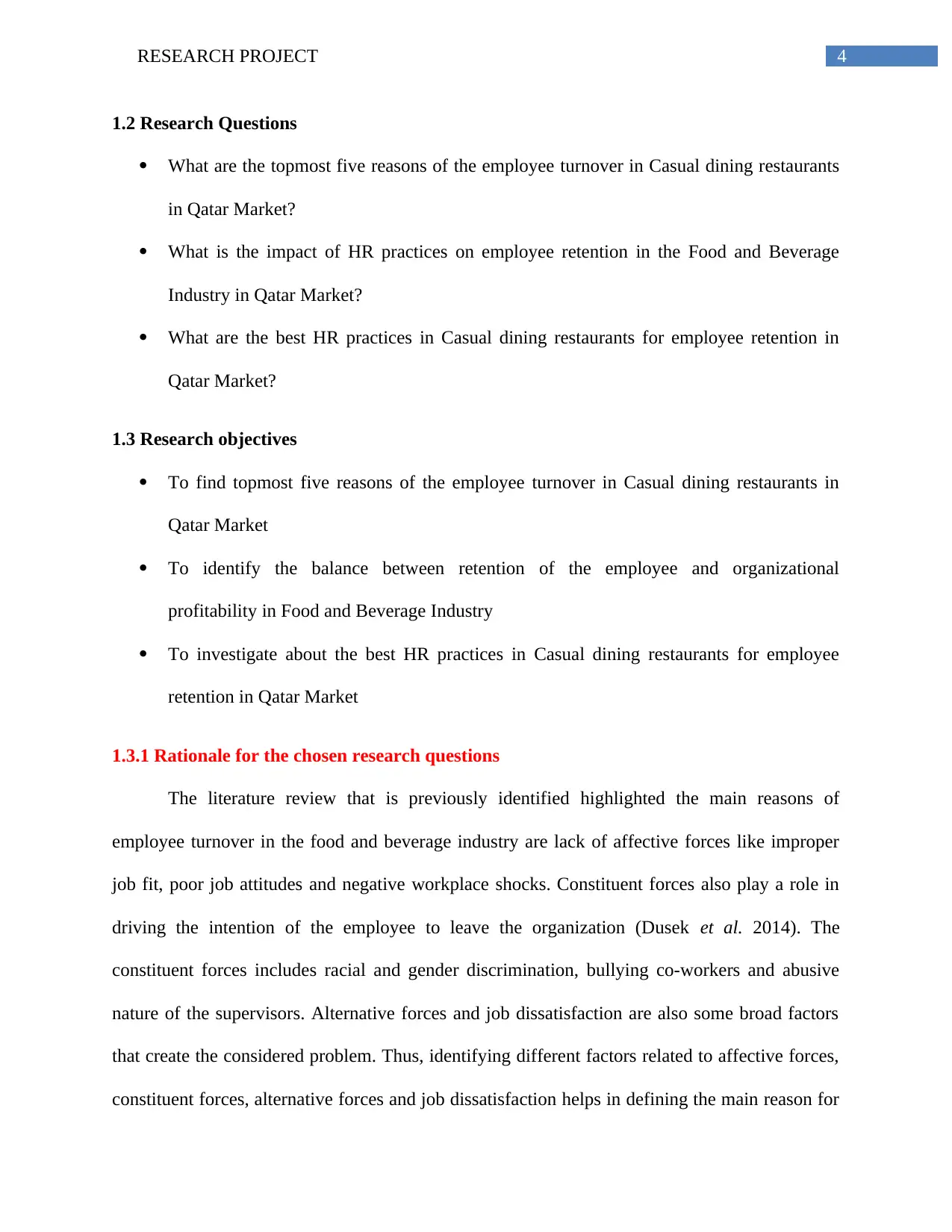
4RESEARCH PROJECT
1.2 Research Questions
What are the topmost five reasons of the employee turnover in Casual dining restaurants
in Qatar Market?
What is the impact of HR practices on employee retention in the Food and Beverage
Industry in Qatar Market?
What are the best HR practices in Casual dining restaurants for employee retention in
Qatar Market?
1.3 Research objectives
To find topmost five reasons of the employee turnover in Casual dining restaurants in
Qatar Market
To identify the balance between retention of the employee and organizational
profitability in Food and Beverage Industry
To investigate about the best HR practices in Casual dining restaurants for employee
retention in Qatar Market
1.3.1 Rationale for the chosen research questions
The literature review that is previously identified highlighted the main reasons of
employee turnover in the food and beverage industry are lack of affective forces like improper
job fit, poor job attitudes and negative workplace shocks. Constituent forces also play a role in
driving the intention of the employee to leave the organization (Dusek et al. 2014). The
constituent forces includes racial and gender discrimination, bullying co-workers and abusive
nature of the supervisors. Alternative forces and job dissatisfaction are also some broad factors
that create the considered problem. Thus, identifying different factors related to affective forces,
constituent forces, alternative forces and job dissatisfaction helps in defining the main reason for
1.2 Research Questions
What are the topmost five reasons of the employee turnover in Casual dining restaurants
in Qatar Market?
What is the impact of HR practices on employee retention in the Food and Beverage
Industry in Qatar Market?
What are the best HR practices in Casual dining restaurants for employee retention in
Qatar Market?
1.3 Research objectives
To find topmost five reasons of the employee turnover in Casual dining restaurants in
Qatar Market
To identify the balance between retention of the employee and organizational
profitability in Food and Beverage Industry
To investigate about the best HR practices in Casual dining restaurants for employee
retention in Qatar Market
1.3.1 Rationale for the chosen research questions
The literature review that is previously identified highlighted the main reasons of
employee turnover in the food and beverage industry are lack of affective forces like improper
job fit, poor job attitudes and negative workplace shocks. Constituent forces also play a role in
driving the intention of the employee to leave the organization (Dusek et al. 2014). The
constituent forces includes racial and gender discrimination, bullying co-workers and abusive
nature of the supervisors. Alternative forces and job dissatisfaction are also some broad factors
that create the considered problem. Thus, identifying different factors related to affective forces,
constituent forces, alternative forces and job dissatisfaction helps in defining the main reason for
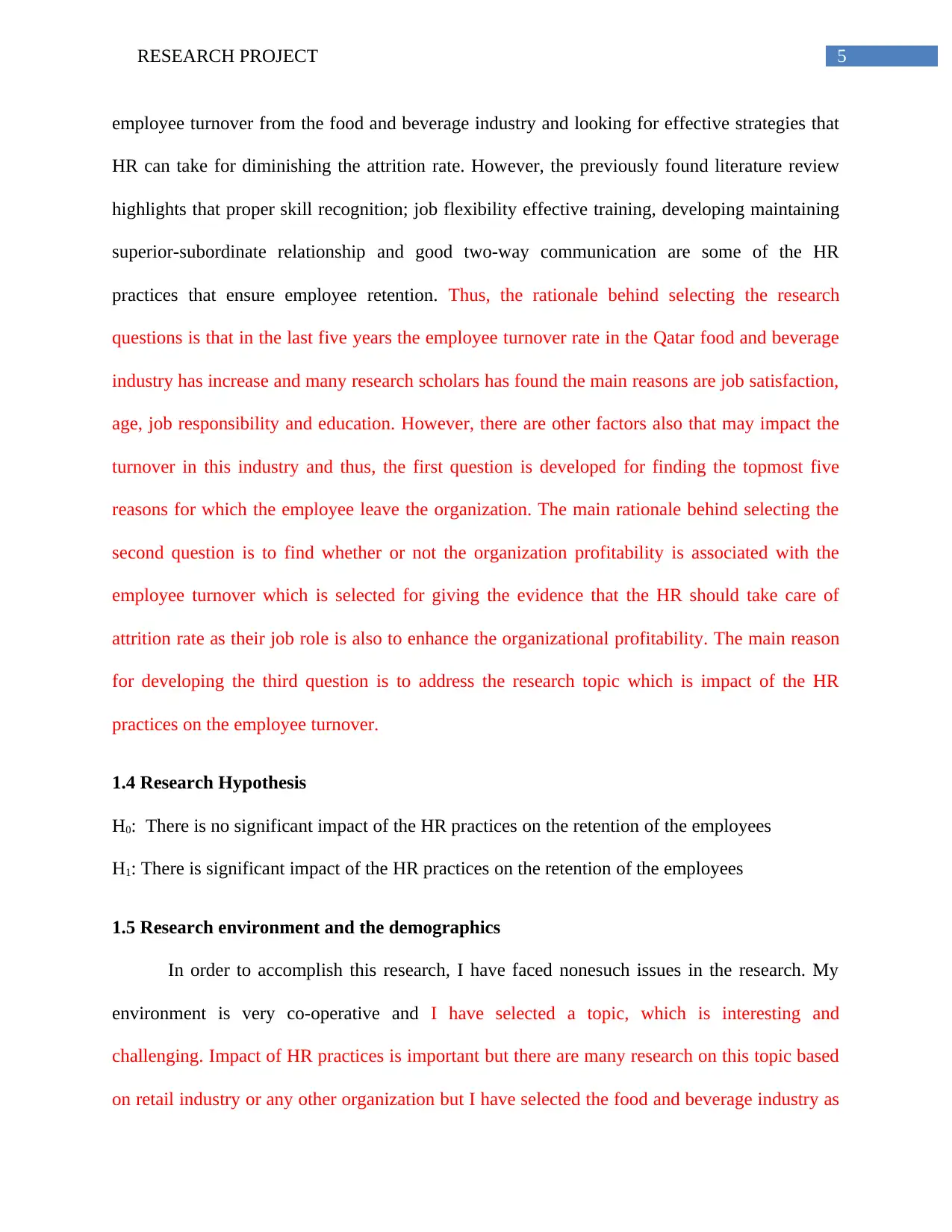
5RESEARCH PROJECT
employee turnover from the food and beverage industry and looking for effective strategies that
HR can take for diminishing the attrition rate. However, the previously found literature review
highlights that proper skill recognition; job flexibility effective training, developing maintaining
superior-subordinate relationship and good two-way communication are some of the HR
practices that ensure employee retention. Thus, the rationale behind selecting the research
questions is that in the last five years the employee turnover rate in the Qatar food and beverage
industry has increase and many research scholars has found the main reasons are job satisfaction,
age, job responsibility and education. However, there are other factors also that may impact the
turnover in this industry and thus, the first question is developed for finding the topmost five
reasons for which the employee leave the organization. The main rationale behind selecting the
second question is to find whether or not the organization profitability is associated with the
employee turnover which is selected for giving the evidence that the HR should take care of
attrition rate as their job role is also to enhance the organizational profitability. The main reason
for developing the third question is to address the research topic which is impact of the HR
practices on the employee turnover.
1.4 Research Hypothesis
H0: There is no significant impact of the HR practices on the retention of the employees
H1: There is significant impact of the HR practices on the retention of the employees
1.5 Research environment and the demographics
In order to accomplish this research, I have faced nonesuch issues in the research. My
environment is very co-operative and I have selected a topic, which is interesting and
challenging. Impact of HR practices is important but there are many research on this topic based
on retail industry or any other organization but I have selected the food and beverage industry as
employee turnover from the food and beverage industry and looking for effective strategies that
HR can take for diminishing the attrition rate. However, the previously found literature review
highlights that proper skill recognition; job flexibility effective training, developing maintaining
superior-subordinate relationship and good two-way communication are some of the HR
practices that ensure employee retention. Thus, the rationale behind selecting the research
questions is that in the last five years the employee turnover rate in the Qatar food and beverage
industry has increase and many research scholars has found the main reasons are job satisfaction,
age, job responsibility and education. However, there are other factors also that may impact the
turnover in this industry and thus, the first question is developed for finding the topmost five
reasons for which the employee leave the organization. The main rationale behind selecting the
second question is to find whether or not the organization profitability is associated with the
employee turnover which is selected for giving the evidence that the HR should take care of
attrition rate as their job role is also to enhance the organizational profitability. The main reason
for developing the third question is to address the research topic which is impact of the HR
practices on the employee turnover.
1.4 Research Hypothesis
H0: There is no significant impact of the HR practices on the retention of the employees
H1: There is significant impact of the HR practices on the retention of the employees
1.5 Research environment and the demographics
In order to accomplish this research, I have faced nonesuch issues in the research. My
environment is very co-operative and I have selected a topic, which is interesting and
challenging. Impact of HR practices is important but there are many research on this topic based
on retail industry or any other organization but I have selected the food and beverage industry as
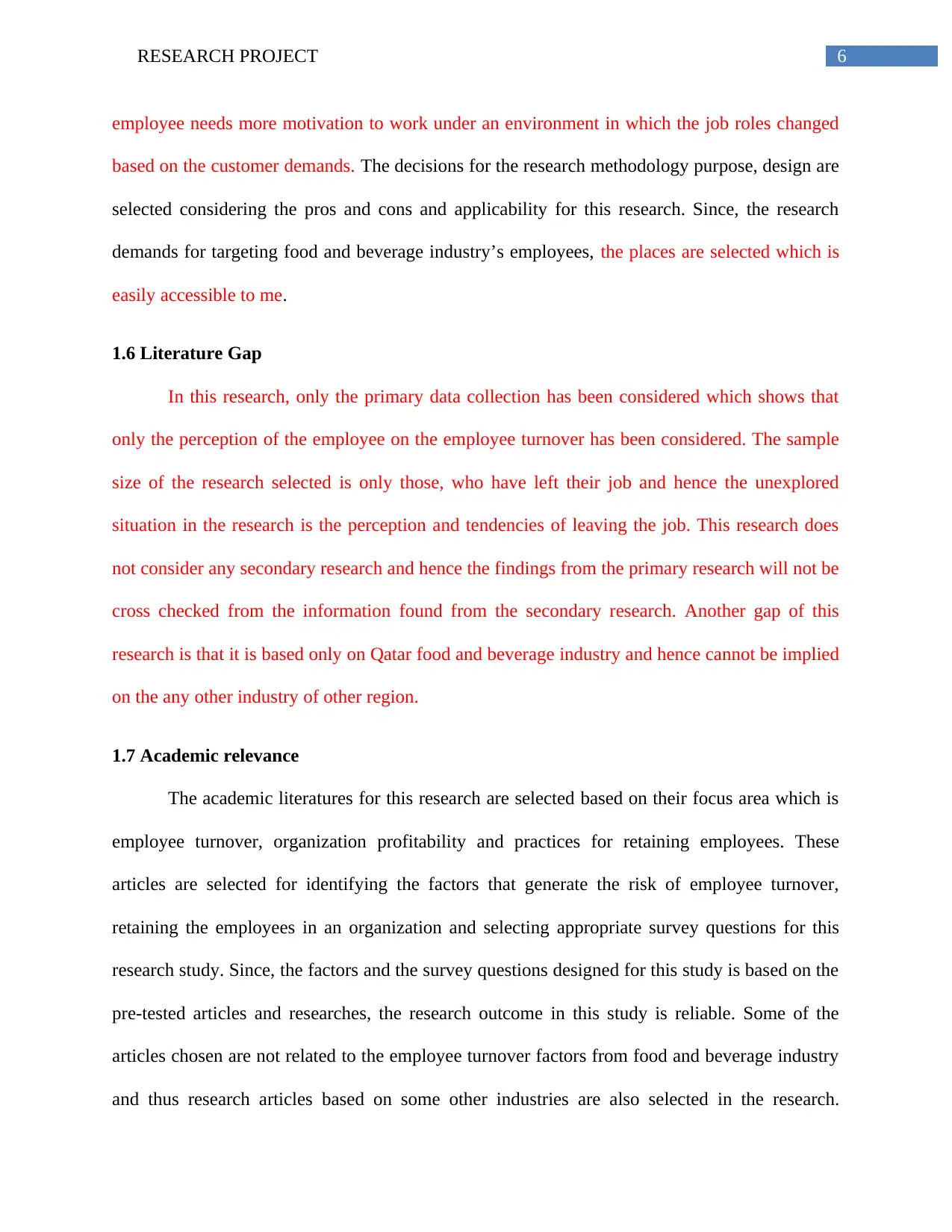
6RESEARCH PROJECT
employee needs more motivation to work under an environment in which the job roles changed
based on the customer demands. The decisions for the research methodology purpose, design are
selected considering the pros and cons and applicability for this research. Since, the research
demands for targeting food and beverage industry’s employees, the places are selected which is
easily accessible to me.
1.6 Literature Gap
In this research, only the primary data collection has been considered which shows that
only the perception of the employee on the employee turnover has been considered. The sample
size of the research selected is only those, who have left their job and hence the unexplored
situation in the research is the perception and tendencies of leaving the job. This research does
not consider any secondary research and hence the findings from the primary research will not be
cross checked from the information found from the secondary research. Another gap of this
research is that it is based only on Qatar food and beverage industry and hence cannot be implied
on the any other industry of other region.
1.7 Academic relevance
The academic literatures for this research are selected based on their focus area which is
employee turnover, organization profitability and practices for retaining employees. These
articles are selected for identifying the factors that generate the risk of employee turnover,
retaining the employees in an organization and selecting appropriate survey questions for this
research study. Since, the factors and the survey questions designed for this study is based on the
pre-tested articles and researches, the research outcome in this study is reliable. Some of the
articles chosen are not related to the employee turnover factors from food and beverage industry
and thus research articles based on some other industries are also selected in the research.
employee needs more motivation to work under an environment in which the job roles changed
based on the customer demands. The decisions for the research methodology purpose, design are
selected considering the pros and cons and applicability for this research. Since, the research
demands for targeting food and beverage industry’s employees, the places are selected which is
easily accessible to me.
1.6 Literature Gap
In this research, only the primary data collection has been considered which shows that
only the perception of the employee on the employee turnover has been considered. The sample
size of the research selected is only those, who have left their job and hence the unexplored
situation in the research is the perception and tendencies of leaving the job. This research does
not consider any secondary research and hence the findings from the primary research will not be
cross checked from the information found from the secondary research. Another gap of this
research is that it is based only on Qatar food and beverage industry and hence cannot be implied
on the any other industry of other region.
1.7 Academic relevance
The academic literatures for this research are selected based on their focus area which is
employee turnover, organization profitability and practices for retaining employees. These
articles are selected for identifying the factors that generate the risk of employee turnover,
retaining the employees in an organization and selecting appropriate survey questions for this
research study. Since, the factors and the survey questions designed for this study is based on the
pre-tested articles and researches, the research outcome in this study is reliable. Some of the
articles chosen are not related to the employee turnover factors from food and beverage industry
and thus research articles based on some other industries are also selected in the research.
Paraphrase This Document
Need a fresh take? Get an instant paraphrase of this document with our AI Paraphraser
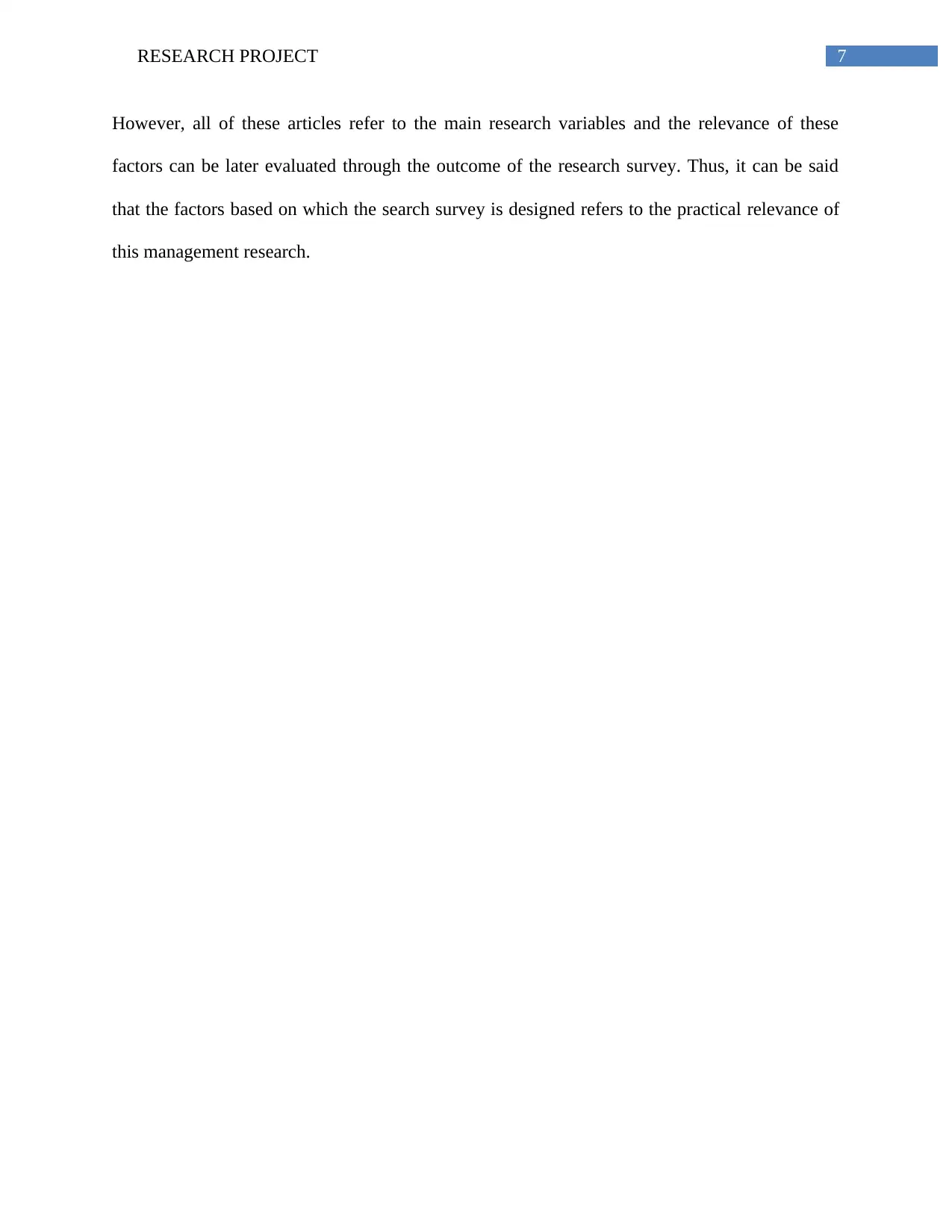
7RESEARCH PROJECT
However, all of these articles refer to the main research variables and the relevance of these
factors can be later evaluated through the outcome of the research survey. Thus, it can be said
that the factors based on which the search survey is designed refers to the practical relevance of
this management research.
However, all of these articles refer to the main research variables and the relevance of these
factors can be later evaluated through the outcome of the research survey. Thus, it can be said
that the factors based on which the search survey is designed refers to the practical relevance of
this management research.

8RESEARCH PROJECT
Chapter 2: Critical Literature Review
2.1 Overview of the Employee turnover
Hancock et al. (2013) is identified employee turnover as departure of an employee from
an organization. Long, Perumal and Ajagbe (2012) also stated that employee turnover illustrates
the state of movement of the employee from the boundary of the organization. It is also
identified by the author that the interest of the employee to retain in an organization is based on
their psychology and sociology and the companies also have to adhere their business literatures
for promoting a healthy working environment. In recent times, companies emphasized more on
the advanced training needs and increased wages to the skilled employees rather than replacing
low-skill, inexpensive workers and easily trainable (Hancock et al. 2013). Mahal (2012) on the
other hand stated that HR’s role is to foster the employee’s engagement unless which the
working personnel from the organization will not retain for longer time. It is also identified that
if the HR values their job responsibility in an efficient manner, employee commitment towards
the working industry can be enhanced. Two factors that are “perceived ease of movement” and
“perceived desirability of movement” is developed by Long, Perumal and Ajagbe (2012) that
defines the reason for employee turnover. “Perceived ease of movement” illustrates the
influenced incident or situation in which the employee searches for job alternatives or
opportunities and the term “perceived desirability of movement” demonstrate the situation that
determines the job satisfaction.
2.2 Relationship between employee turnover intentions and HRM practices
Long, Perumal and Ajagbe (2012) depicted that some of the crucial HRM practices that
can increase the risk of employee turnover are shrinking pool of entry-level workers, recruitment
Chapter 2: Critical Literature Review
2.1 Overview of the Employee turnover
Hancock et al. (2013) is identified employee turnover as departure of an employee from
an organization. Long, Perumal and Ajagbe (2012) also stated that employee turnover illustrates
the state of movement of the employee from the boundary of the organization. It is also
identified by the author that the interest of the employee to retain in an organization is based on
their psychology and sociology and the companies also have to adhere their business literatures
for promoting a healthy working environment. In recent times, companies emphasized more on
the advanced training needs and increased wages to the skilled employees rather than replacing
low-skill, inexpensive workers and easily trainable (Hancock et al. 2013). Mahal (2012) on the
other hand stated that HR’s role is to foster the employee’s engagement unless which the
working personnel from the organization will not retain for longer time. It is also identified that
if the HR values their job responsibility in an efficient manner, employee commitment towards
the working industry can be enhanced. Two factors that are “perceived ease of movement” and
“perceived desirability of movement” is developed by Long, Perumal and Ajagbe (2012) that
defines the reason for employee turnover. “Perceived ease of movement” illustrates the
influenced incident or situation in which the employee searches for job alternatives or
opportunities and the term “perceived desirability of movement” demonstrate the situation that
determines the job satisfaction.
2.2 Relationship between employee turnover intentions and HRM practices
Long, Perumal and Ajagbe (2012) depicted that some of the crucial HRM practices that
can increase the risk of employee turnover are shrinking pool of entry-level workers, recruitment
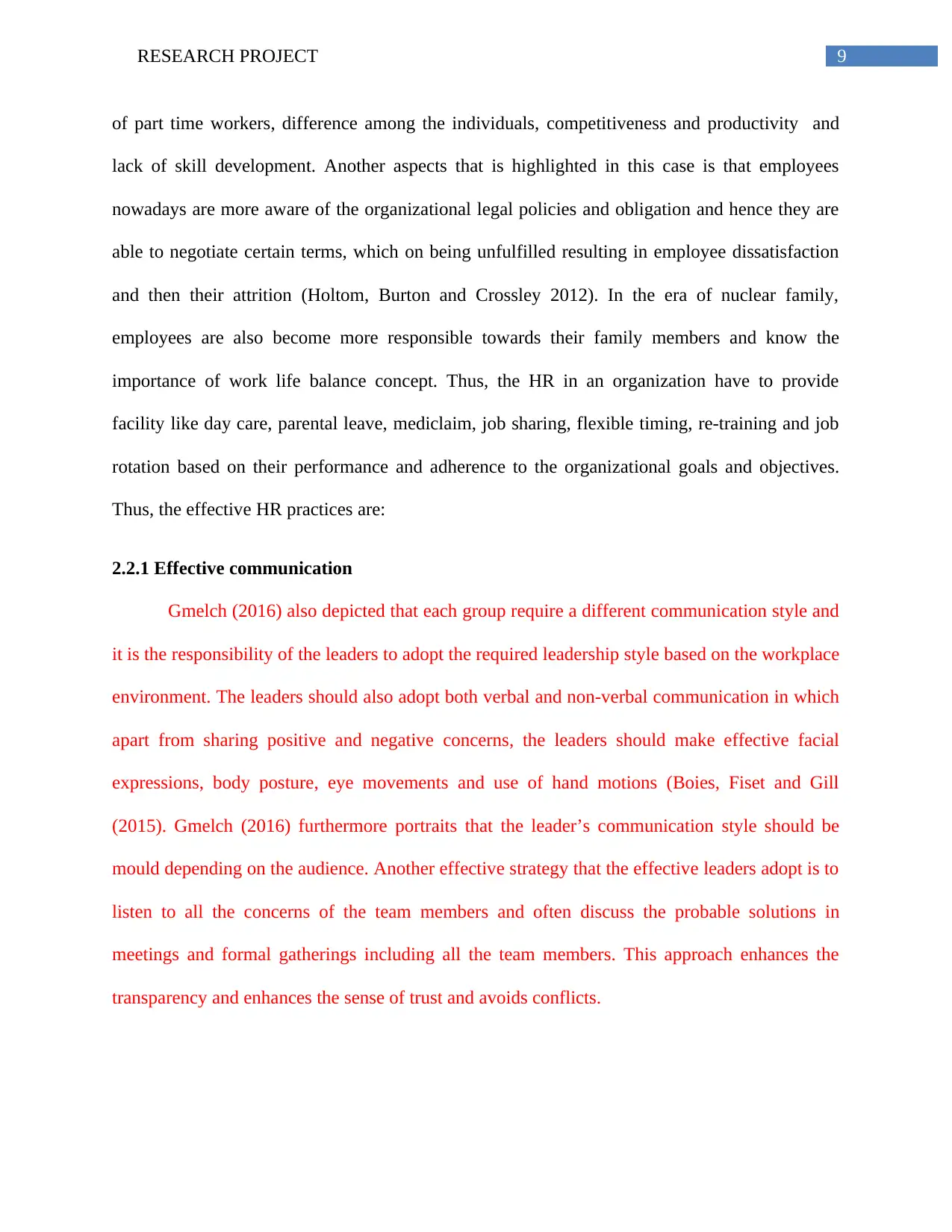
9RESEARCH PROJECT
of part time workers, difference among the individuals, competitiveness and productivity and
lack of skill development. Another aspects that is highlighted in this case is that employees
nowadays are more aware of the organizational legal policies and obligation and hence they are
able to negotiate certain terms, which on being unfulfilled resulting in employee dissatisfaction
and then their attrition (Holtom, Burton and Crossley 2012). In the era of nuclear family,
employees are also become more responsible towards their family members and know the
importance of work life balance concept. Thus, the HR in an organization have to provide
facility like day care, parental leave, mediclaim, job sharing, flexible timing, re-training and job
rotation based on their performance and adherence to the organizational goals and objectives.
Thus, the effective HR practices are:
2.2.1 Effective communication
Gmelch (2016) also depicted that each group require a different communication style and
it is the responsibility of the leaders to adopt the required leadership style based on the workplace
environment. The leaders should also adopt both verbal and non-verbal communication in which
apart from sharing positive and negative concerns, the leaders should make effective facial
expressions, body posture, eye movements and use of hand motions (Boies, Fiset and Gill
(2015). Gmelch (2016) furthermore portraits that the leader’s communication style should be
mould depending on the audience. Another effective strategy that the effective leaders adopt is to
listen to all the concerns of the team members and often discuss the probable solutions in
meetings and formal gatherings including all the team members. This approach enhances the
transparency and enhances the sense of trust and avoids conflicts.
of part time workers, difference among the individuals, competitiveness and productivity and
lack of skill development. Another aspects that is highlighted in this case is that employees
nowadays are more aware of the organizational legal policies and obligation and hence they are
able to negotiate certain terms, which on being unfulfilled resulting in employee dissatisfaction
and then their attrition (Holtom, Burton and Crossley 2012). In the era of nuclear family,
employees are also become more responsible towards their family members and know the
importance of work life balance concept. Thus, the HR in an organization have to provide
facility like day care, parental leave, mediclaim, job sharing, flexible timing, re-training and job
rotation based on their performance and adherence to the organizational goals and objectives.
Thus, the effective HR practices are:
2.2.1 Effective communication
Gmelch (2016) also depicted that each group require a different communication style and
it is the responsibility of the leaders to adopt the required leadership style based on the workplace
environment. The leaders should also adopt both verbal and non-verbal communication in which
apart from sharing positive and negative concerns, the leaders should make effective facial
expressions, body posture, eye movements and use of hand motions (Boies, Fiset and Gill
(2015). Gmelch (2016) furthermore portraits that the leader’s communication style should be
mould depending on the audience. Another effective strategy that the effective leaders adopt is to
listen to all the concerns of the team members and often discuss the probable solutions in
meetings and formal gatherings including all the team members. This approach enhances the
transparency and enhances the sense of trust and avoids conflicts.
Secure Best Marks with AI Grader
Need help grading? Try our AI Grader for instant feedback on your assignments.
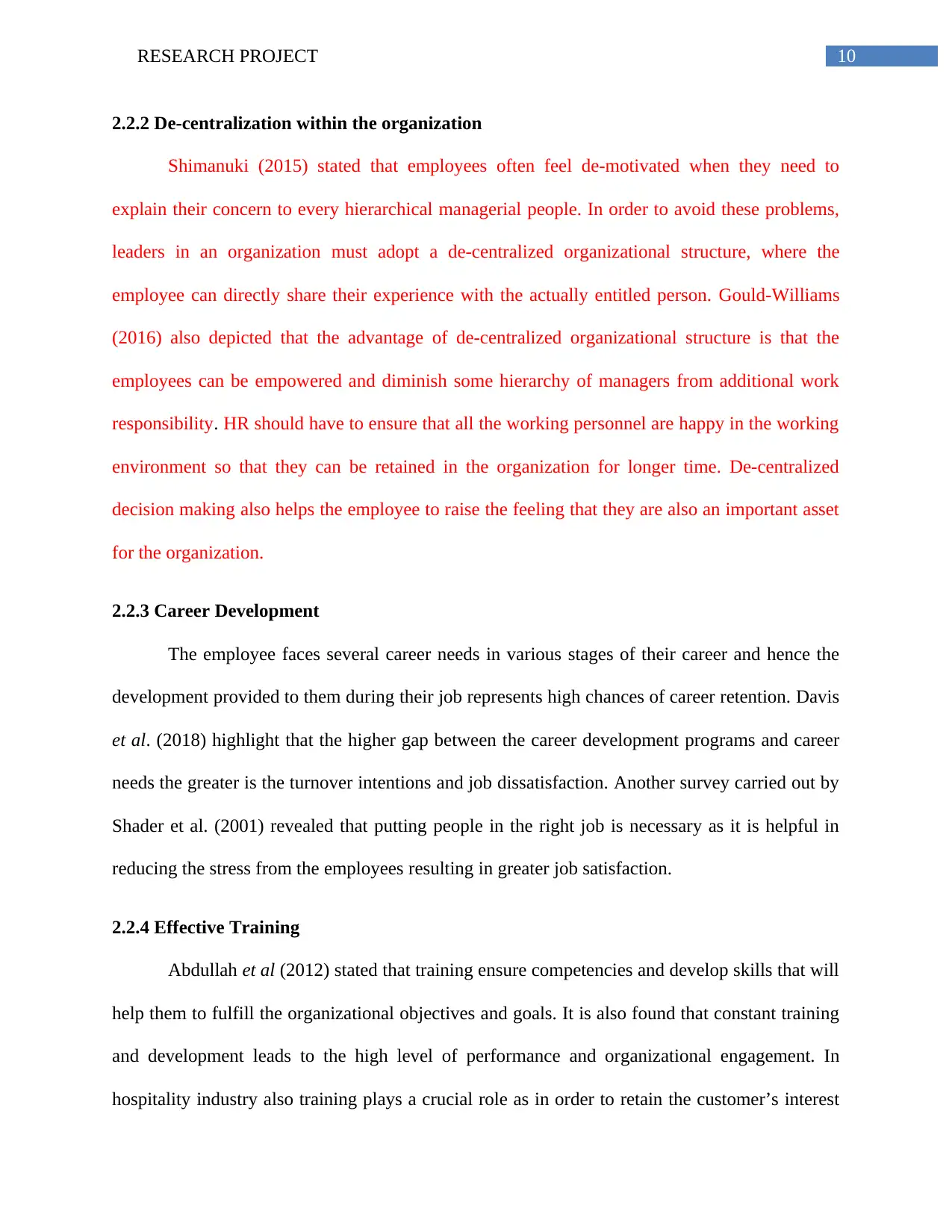
10RESEARCH PROJECT
2.2.2 De-centralization within the organization
Shimanuki (2015) stated that employees often feel de-motivated when they need to
explain their concern to every hierarchical managerial people. In order to avoid these problems,
leaders in an organization must adopt a de-centralized organizational structure, where the
employee can directly share their experience with the actually entitled person. Gould-Williams
(2016) also depicted that the advantage of de-centralized organizational structure is that the
employees can be empowered and diminish some hierarchy of managers from additional work
responsibility. HR should have to ensure that all the working personnel are happy in the working
environment so that they can be retained in the organization for longer time. De-centralized
decision making also helps the employee to raise the feeling that they are also an important asset
for the organization.
2.2.3 Career Development
The employee faces several career needs in various stages of their career and hence the
development provided to them during their job represents high chances of career retention. Davis
et al. (2018) highlight that the higher gap between the career development programs and career
needs the greater is the turnover intentions and job dissatisfaction. Another survey carried out by
Shader et al. (2001) revealed that putting people in the right job is necessary as it is helpful in
reducing the stress from the employees resulting in greater job satisfaction.
2.2.4 Effective Training
Abdullah et al (2012) stated that training ensure competencies and develop skills that will
help them to fulfill the organizational objectives and goals. It is also found that constant training
and development leads to the high level of performance and organizational engagement. In
hospitality industry also training plays a crucial role as in order to retain the customer’s interest
2.2.2 De-centralization within the organization
Shimanuki (2015) stated that employees often feel de-motivated when they need to
explain their concern to every hierarchical managerial people. In order to avoid these problems,
leaders in an organization must adopt a de-centralized organizational structure, where the
employee can directly share their experience with the actually entitled person. Gould-Williams
(2016) also depicted that the advantage of de-centralized organizational structure is that the
employees can be empowered and diminish some hierarchy of managers from additional work
responsibility. HR should have to ensure that all the working personnel are happy in the working
environment so that they can be retained in the organization for longer time. De-centralized
decision making also helps the employee to raise the feeling that they are also an important asset
for the organization.
2.2.3 Career Development
The employee faces several career needs in various stages of their career and hence the
development provided to them during their job represents high chances of career retention. Davis
et al. (2018) highlight that the higher gap between the career development programs and career
needs the greater is the turnover intentions and job dissatisfaction. Another survey carried out by
Shader et al. (2001) revealed that putting people in the right job is necessary as it is helpful in
reducing the stress from the employees resulting in greater job satisfaction.
2.2.4 Effective Training
Abdullah et al (2012) stated that training ensure competencies and develop skills that will
help them to fulfill the organizational objectives and goals. It is also found that constant training
and development leads to the high level of performance and organizational engagement. In
hospitality industry also training plays a crucial role as in order to retain the customer’s interest
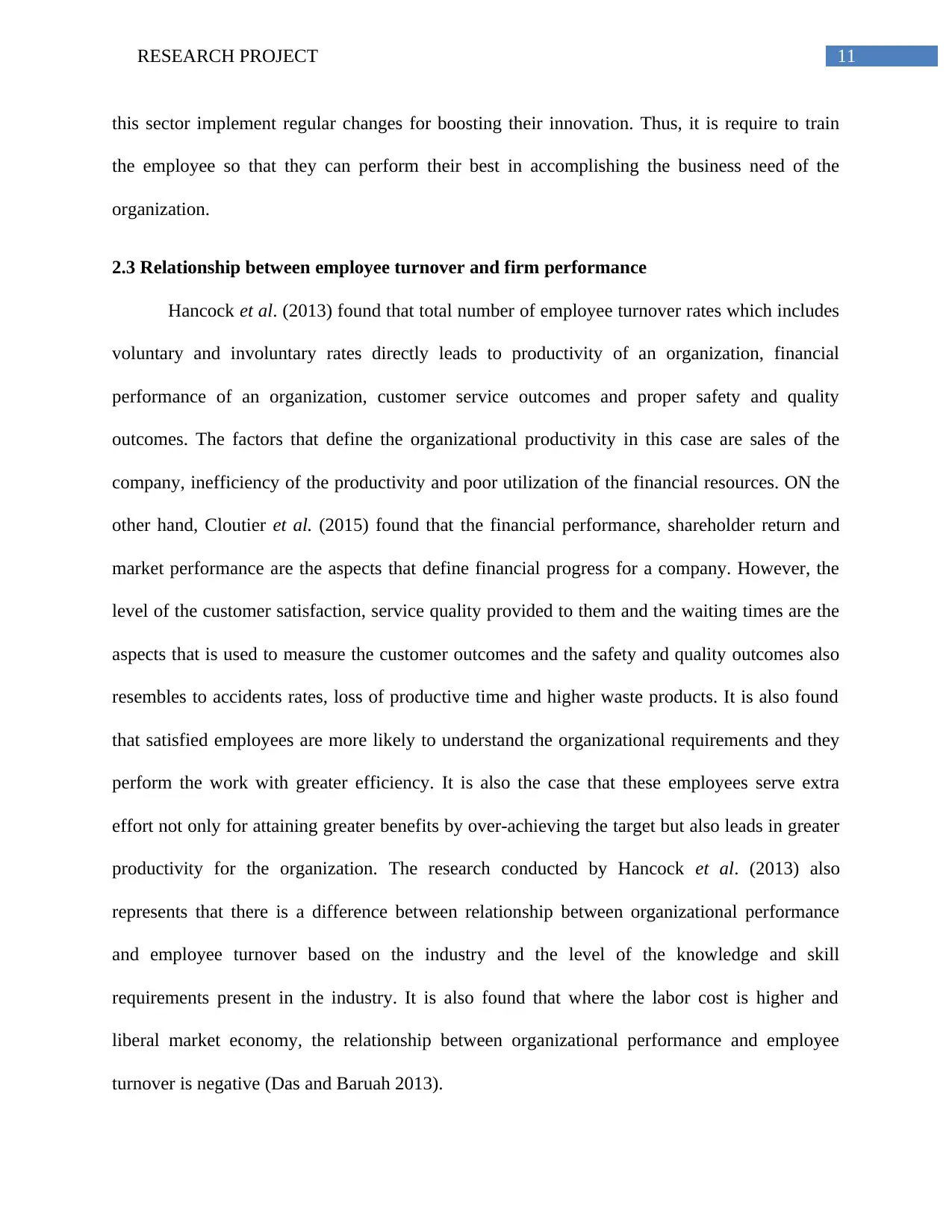
11RESEARCH PROJECT
this sector implement regular changes for boosting their innovation. Thus, it is require to train
the employee so that they can perform their best in accomplishing the business need of the
organization.
2.3 Relationship between employee turnover and firm performance
Hancock et al. (2013) found that total number of employee turnover rates which includes
voluntary and involuntary rates directly leads to productivity of an organization, financial
performance of an organization, customer service outcomes and proper safety and quality
outcomes. The factors that define the organizational productivity in this case are sales of the
company, inefficiency of the productivity and poor utilization of the financial resources. ON the
other hand, Cloutier et al. (2015) found that the financial performance, shareholder return and
market performance are the aspects that define financial progress for a company. However, the
level of the customer satisfaction, service quality provided to them and the waiting times are the
aspects that is used to measure the customer outcomes and the safety and quality outcomes also
resembles to accidents rates, loss of productive time and higher waste products. It is also found
that satisfied employees are more likely to understand the organizational requirements and they
perform the work with greater efficiency. It is also the case that these employees serve extra
effort not only for attaining greater benefits by over-achieving the target but also leads in greater
productivity for the organization. The research conducted by Hancock et al. (2013) also
represents that there is a difference between relationship between organizational performance
and employee turnover based on the industry and the level of the knowledge and skill
requirements present in the industry. It is also found that where the labor cost is higher and
liberal market economy, the relationship between organizational performance and employee
turnover is negative (Das and Baruah 2013).
this sector implement regular changes for boosting their innovation. Thus, it is require to train
the employee so that they can perform their best in accomplishing the business need of the
organization.
2.3 Relationship between employee turnover and firm performance
Hancock et al. (2013) found that total number of employee turnover rates which includes
voluntary and involuntary rates directly leads to productivity of an organization, financial
performance of an organization, customer service outcomes and proper safety and quality
outcomes. The factors that define the organizational productivity in this case are sales of the
company, inefficiency of the productivity and poor utilization of the financial resources. ON the
other hand, Cloutier et al. (2015) found that the financial performance, shareholder return and
market performance are the aspects that define financial progress for a company. However, the
level of the customer satisfaction, service quality provided to them and the waiting times are the
aspects that is used to measure the customer outcomes and the safety and quality outcomes also
resembles to accidents rates, loss of productive time and higher waste products. It is also found
that satisfied employees are more likely to understand the organizational requirements and they
perform the work with greater efficiency. It is also the case that these employees serve extra
effort not only for attaining greater benefits by over-achieving the target but also leads in greater
productivity for the organization. The research conducted by Hancock et al. (2013) also
represents that there is a difference between relationship between organizational performance
and employee turnover based on the industry and the level of the knowledge and skill
requirements present in the industry. It is also found that where the labor cost is higher and
liberal market economy, the relationship between organizational performance and employee
turnover is negative (Das and Baruah 2013).
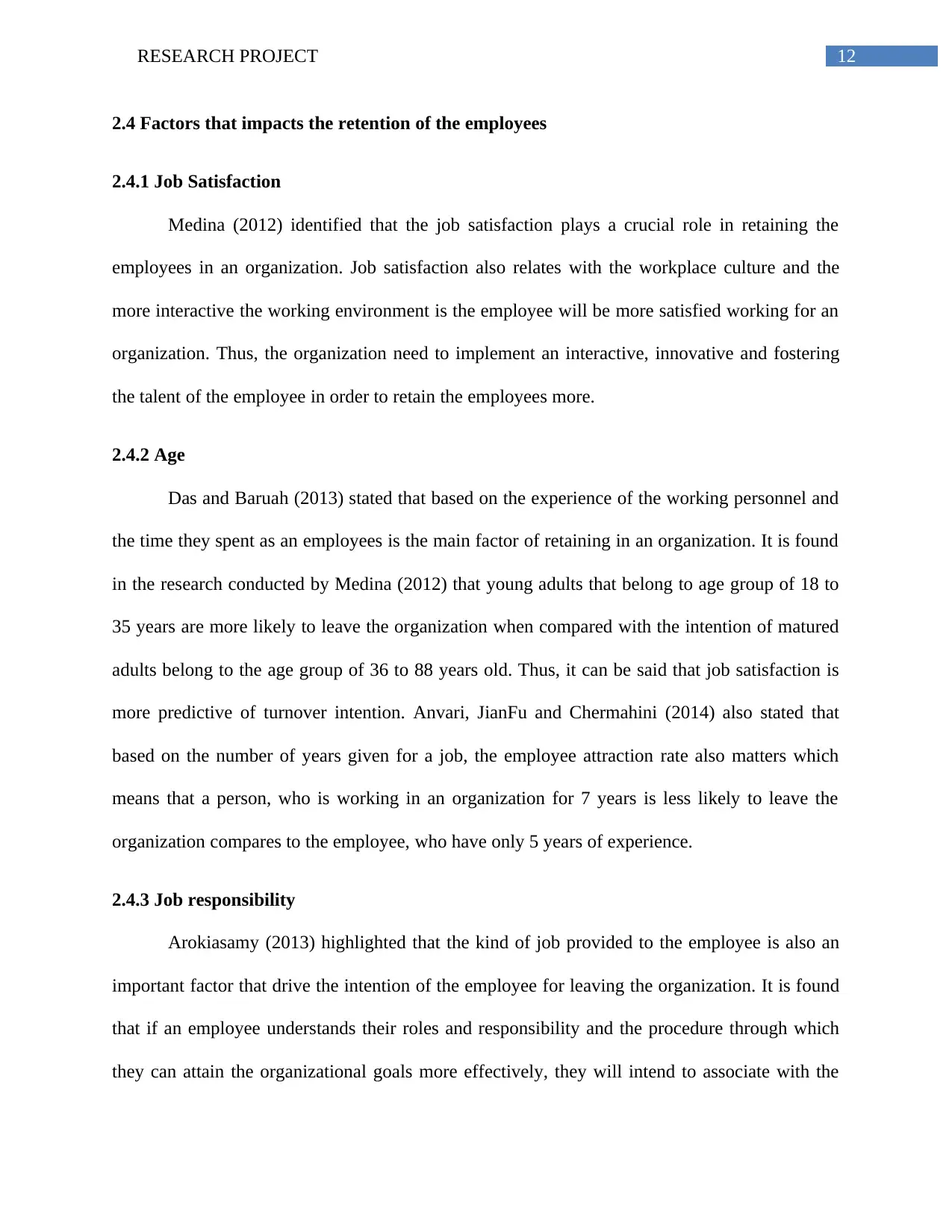
12RESEARCH PROJECT
2.4 Factors that impacts the retention of the employees
2.4.1 Job Satisfaction
Medina (2012) identified that the job satisfaction plays a crucial role in retaining the
employees in an organization. Job satisfaction also relates with the workplace culture and the
more interactive the working environment is the employee will be more satisfied working for an
organization. Thus, the organization need to implement an interactive, innovative and fostering
the talent of the employee in order to retain the employees more.
2.4.2 Age
Das and Baruah (2013) stated that based on the experience of the working personnel and
the time they spent as an employees is the main factor of retaining in an organization. It is found
in the research conducted by Medina (2012) that young adults that belong to age group of 18 to
35 years are more likely to leave the organization when compared with the intention of matured
adults belong to the age group of 36 to 88 years old. Thus, it can be said that job satisfaction is
more predictive of turnover intention. Anvari, JianFu and Chermahini (2014) also stated that
based on the number of years given for a job, the employee attraction rate also matters which
means that a person, who is working in an organization for 7 years is less likely to leave the
organization compares to the employee, who have only 5 years of experience.
2.4.3 Job responsibility
Arokiasamy (2013) highlighted that the kind of job provided to the employee is also an
important factor that drive the intention of the employee for leaving the organization. It is found
that if an employee understands their roles and responsibility and the procedure through which
they can attain the organizational goals more effectively, they will intend to associate with the
2.4 Factors that impacts the retention of the employees
2.4.1 Job Satisfaction
Medina (2012) identified that the job satisfaction plays a crucial role in retaining the
employees in an organization. Job satisfaction also relates with the workplace culture and the
more interactive the working environment is the employee will be more satisfied working for an
organization. Thus, the organization need to implement an interactive, innovative and fostering
the talent of the employee in order to retain the employees more.
2.4.2 Age
Das and Baruah (2013) stated that based on the experience of the working personnel and
the time they spent as an employees is the main factor of retaining in an organization. It is found
in the research conducted by Medina (2012) that young adults that belong to age group of 18 to
35 years are more likely to leave the organization when compared with the intention of matured
adults belong to the age group of 36 to 88 years old. Thus, it can be said that job satisfaction is
more predictive of turnover intention. Anvari, JianFu and Chermahini (2014) also stated that
based on the number of years given for a job, the employee attraction rate also matters which
means that a person, who is working in an organization for 7 years is less likely to leave the
organization compares to the employee, who have only 5 years of experience.
2.4.3 Job responsibility
Arokiasamy (2013) highlighted that the kind of job provided to the employee is also an
important factor that drive the intention of the employee for leaving the organization. It is found
that if an employee understands their roles and responsibility and the procedure through which
they can attain the organizational goals more effectively, they will intend to associate with the
Paraphrase This Document
Need a fresh take? Get an instant paraphrase of this document with our AI Paraphraser
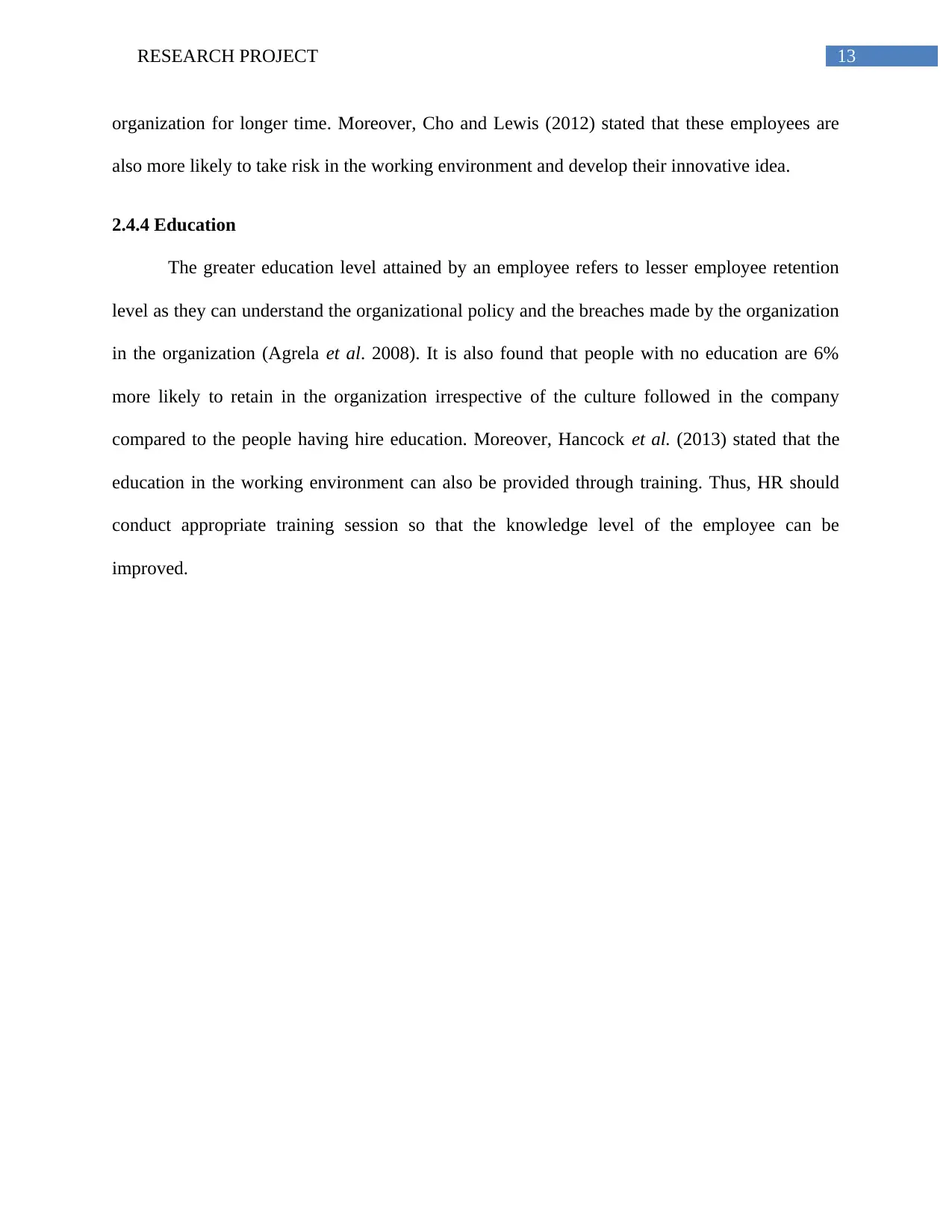
13RESEARCH PROJECT
organization for longer time. Moreover, Cho and Lewis (2012) stated that these employees are
also more likely to take risk in the working environment and develop their innovative idea.
2.4.4 Education
The greater education level attained by an employee refers to lesser employee retention
level as they can understand the organizational policy and the breaches made by the organization
in the organization (Agrela et al. 2008). It is also found that people with no education are 6%
more likely to retain in the organization irrespective of the culture followed in the company
compared to the people having hire education. Moreover, Hancock et al. (2013) stated that the
education in the working environment can also be provided through training. Thus, HR should
conduct appropriate training session so that the knowledge level of the employee can be
improved.
organization for longer time. Moreover, Cho and Lewis (2012) stated that these employees are
also more likely to take risk in the working environment and develop their innovative idea.
2.4.4 Education
The greater education level attained by an employee refers to lesser employee retention
level as they can understand the organizational policy and the breaches made by the organization
in the organization (Agrela et al. 2008). It is also found that people with no education are 6%
more likely to retain in the organization irrespective of the culture followed in the company
compared to the people having hire education. Moreover, Hancock et al. (2013) stated that the
education in the working environment can also be provided through training. Thus, HR should
conduct appropriate training session so that the knowledge level of the employee can be
improved.
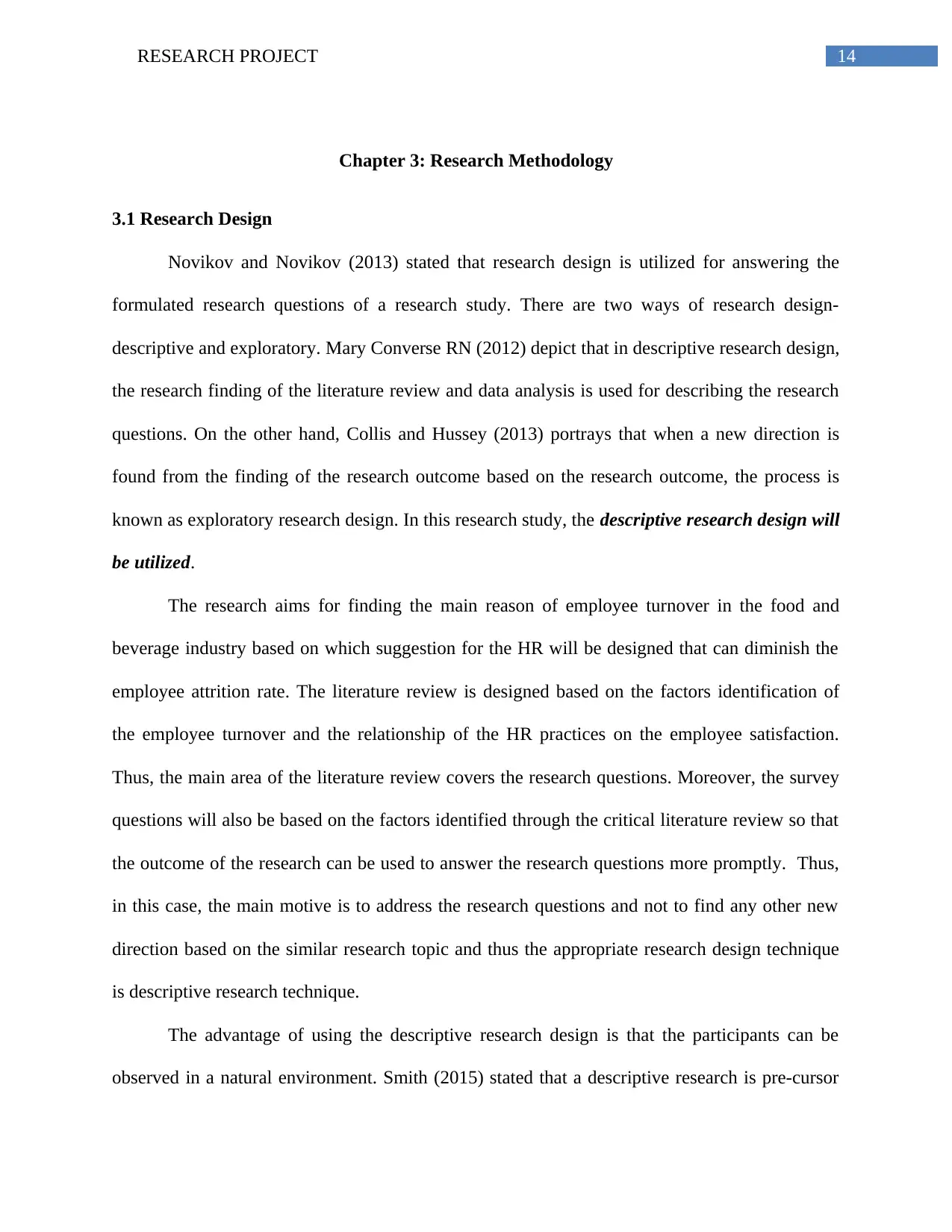
14RESEARCH PROJECT
Chapter 3: Research Methodology
3.1 Research Design
Novikov and Novikov (2013) stated that research design is utilized for answering the
formulated research questions of a research study. There are two ways of research design-
descriptive and exploratory. Mary Converse RN (2012) depict that in descriptive research design,
the research finding of the literature review and data analysis is used for describing the research
questions. On the other hand, Collis and Hussey (2013) portrays that when a new direction is
found from the finding of the research outcome based on the research outcome, the process is
known as exploratory research design. In this research study, the descriptive research design will
be utilized.
The research aims for finding the main reason of employee turnover in the food and
beverage industry based on which suggestion for the HR will be designed that can diminish the
employee attrition rate. The literature review is designed based on the factors identification of
the employee turnover and the relationship of the HR practices on the employee satisfaction.
Thus, the main area of the literature review covers the research questions. Moreover, the survey
questions will also be based on the factors identified through the critical literature review so that
the outcome of the research can be used to answer the research questions more promptly. Thus,
in this case, the main motive is to address the research questions and not to find any other new
direction based on the similar research topic and thus the appropriate research design technique
is descriptive research technique.
The advantage of using the descriptive research design is that the participants can be
observed in a natural environment. Smith (2015) stated that a descriptive research is pre-cursor
Chapter 3: Research Methodology
3.1 Research Design
Novikov and Novikov (2013) stated that research design is utilized for answering the
formulated research questions of a research study. There are two ways of research design-
descriptive and exploratory. Mary Converse RN (2012) depict that in descriptive research design,
the research finding of the literature review and data analysis is used for describing the research
questions. On the other hand, Collis and Hussey (2013) portrays that when a new direction is
found from the finding of the research outcome based on the research outcome, the process is
known as exploratory research design. In this research study, the descriptive research design will
be utilized.
The research aims for finding the main reason of employee turnover in the food and
beverage industry based on which suggestion for the HR will be designed that can diminish the
employee attrition rate. The literature review is designed based on the factors identification of
the employee turnover and the relationship of the HR practices on the employee satisfaction.
Thus, the main area of the literature review covers the research questions. Moreover, the survey
questions will also be based on the factors identified through the critical literature review so that
the outcome of the research can be used to answer the research questions more promptly. Thus,
in this case, the main motive is to address the research questions and not to find any other new
direction based on the similar research topic and thus the appropriate research design technique
is descriptive research technique.
The advantage of using the descriptive research design is that the participants can be
observed in a natural environment. Smith (2015) stated that a descriptive research is pre-cursor

15RESEARCH PROJECT
to future research as it determines variables for a research that can be tested. This research design
can also be applicable to both type of research that is quantitatively and qualitatively. Zikmund et
al. (2013) also stated that the descriptive research leads to data rich research. On the other hand
Punch (2013) argued that by stating that though descriptive research includes survey, which is
used by organizations to study in beliefs, behaviors and attitudes of the target audience but in this
case confidentiality can be an issue. Neuman (2013) also highlighted the negative point that the
research conductor can be biased in designing the survey form in order to obtain the best possible
result for the result. Moreover, the respondents will not be truthful while depicting their answers
on the developed research questions.
3.2 Operationalisation
This research will utilize the survey methods. The survey questionnaire will be designed
in a way so that the research variable can be addressed which in this research study is HR
practices and employee retention. A research hypothesis is also formulated in which the
alternative hypothesis is “there is a significant impact of the HR practices on the retention of the
employees”. The questionnaire based on these research variables will be designed on the factor
that is identified through the literature review. This signifies that the factors that is identified s
the main reasons for employee retention in an organization will be used to formulated research
questions for the survey.
3.3 Sampling and recruitment strategy
Levy and Lemeshow (2013) highlighted that there are two different ways through which
the samples for a research can be selected- probability and non-probability sampling technique.
Etikan, Musa and Alkassim (2016) stated that in probability sampling technique, the research
respondents are provided equal opportunity to participate in the research; whereas, when the
to future research as it determines variables for a research that can be tested. This research design
can also be applicable to both type of research that is quantitatively and qualitatively. Zikmund et
al. (2013) also stated that the descriptive research leads to data rich research. On the other hand
Punch (2013) argued that by stating that though descriptive research includes survey, which is
used by organizations to study in beliefs, behaviors and attitudes of the target audience but in this
case confidentiality can be an issue. Neuman (2013) also highlighted the negative point that the
research conductor can be biased in designing the survey form in order to obtain the best possible
result for the result. Moreover, the respondents will not be truthful while depicting their answers
on the developed research questions.
3.2 Operationalisation
This research will utilize the survey methods. The survey questionnaire will be designed
in a way so that the research variable can be addressed which in this research study is HR
practices and employee retention. A research hypothesis is also formulated in which the
alternative hypothesis is “there is a significant impact of the HR practices on the retention of the
employees”. The questionnaire based on these research variables will be designed on the factor
that is identified through the literature review. This signifies that the factors that is identified s
the main reasons for employee retention in an organization will be used to formulated research
questions for the survey.
3.3 Sampling and recruitment strategy
Levy and Lemeshow (2013) highlighted that there are two different ways through which
the samples for a research can be selected- probability and non-probability sampling technique.
Etikan, Musa and Alkassim (2016) stated that in probability sampling technique, the research
respondents are provided equal opportunity to participate in the research; whereas, when the
Secure Best Marks with AI Grader
Need help grading? Try our AI Grader for instant feedback on your assignments.
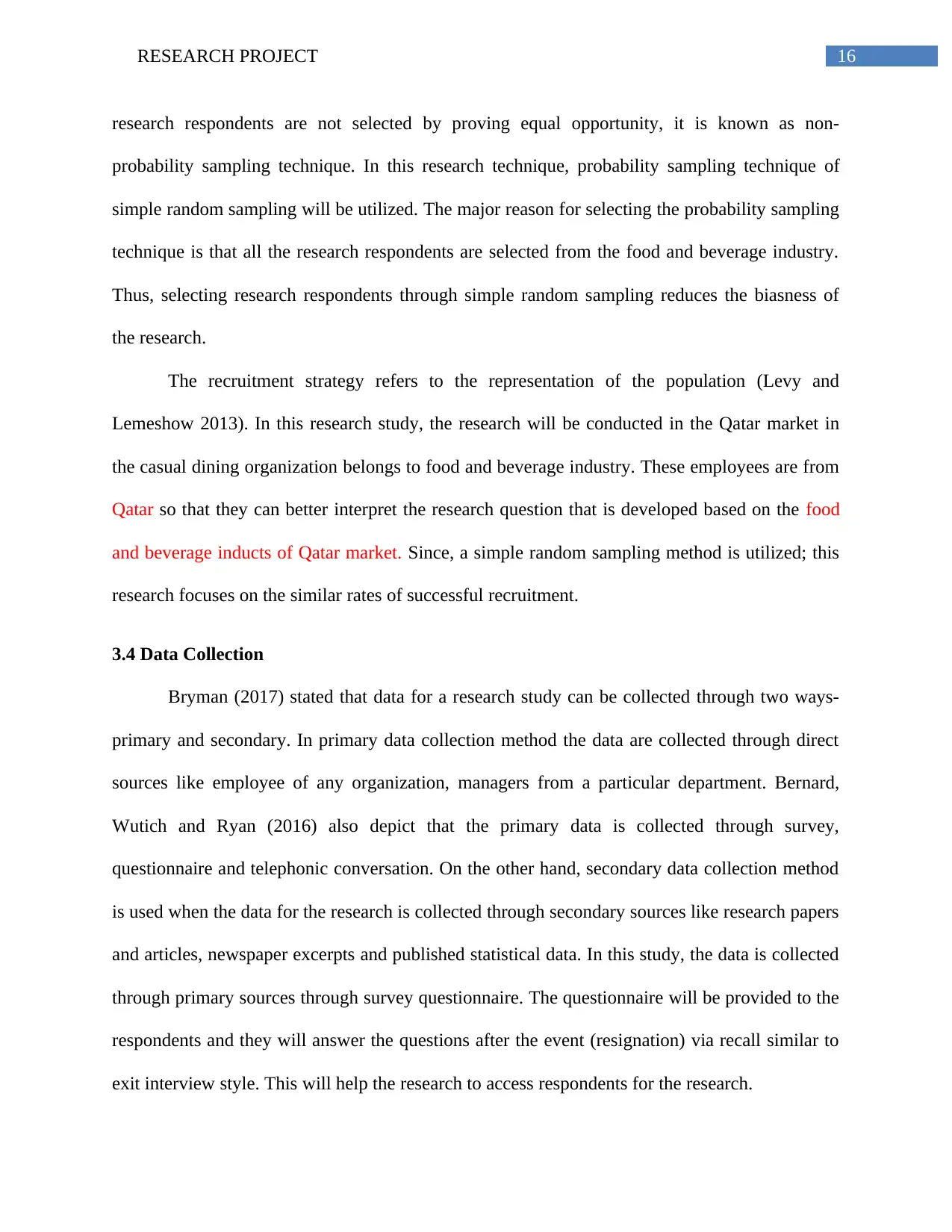
16RESEARCH PROJECT
research respondents are not selected by proving equal opportunity, it is known as non-
probability sampling technique. In this research technique, probability sampling technique of
simple random sampling will be utilized. The major reason for selecting the probability sampling
technique is that all the research respondents are selected from the food and beverage industry.
Thus, selecting research respondents through simple random sampling reduces the biasness of
the research.
The recruitment strategy refers to the representation of the population (Levy and
Lemeshow 2013). In this research study, the research will be conducted in the Qatar market in
the casual dining organization belongs to food and beverage industry. These employees are from
Qatar so that they can better interpret the research question that is developed based on the food
and beverage inducts of Qatar market. Since, a simple random sampling method is utilized; this
research focuses on the similar rates of successful recruitment.
3.4 Data Collection
Bryman (2017) stated that data for a research study can be collected through two ways-
primary and secondary. In primary data collection method the data are collected through direct
sources like employee of any organization, managers from a particular department. Bernard,
Wutich and Ryan (2016) also depict that the primary data is collected through survey,
questionnaire and telephonic conversation. On the other hand, secondary data collection method
is used when the data for the research is collected through secondary sources like research papers
and articles, newspaper excerpts and published statistical data. In this study, the data is collected
through primary sources through survey questionnaire. The questionnaire will be provided to the
respondents and they will answer the questions after the event (resignation) via recall similar to
exit interview style. This will help the research to access respondents for the research.
research respondents are not selected by proving equal opportunity, it is known as non-
probability sampling technique. In this research technique, probability sampling technique of
simple random sampling will be utilized. The major reason for selecting the probability sampling
technique is that all the research respondents are selected from the food and beverage industry.
Thus, selecting research respondents through simple random sampling reduces the biasness of
the research.
The recruitment strategy refers to the representation of the population (Levy and
Lemeshow 2013). In this research study, the research will be conducted in the Qatar market in
the casual dining organization belongs to food and beverage industry. These employees are from
Qatar so that they can better interpret the research question that is developed based on the food
and beverage inducts of Qatar market. Since, a simple random sampling method is utilized; this
research focuses on the similar rates of successful recruitment.
3.4 Data Collection
Bryman (2017) stated that data for a research study can be collected through two ways-
primary and secondary. In primary data collection method the data are collected through direct
sources like employee of any organization, managers from a particular department. Bernard,
Wutich and Ryan (2016) also depict that the primary data is collected through survey,
questionnaire and telephonic conversation. On the other hand, secondary data collection method
is used when the data for the research is collected through secondary sources like research papers
and articles, newspaper excerpts and published statistical data. In this study, the data is collected
through primary sources through survey questionnaire. The questionnaire will be provided to the
respondents and they will answer the questions after the event (resignation) via recall similar to
exit interview style. This will help the research to access respondents for the research.
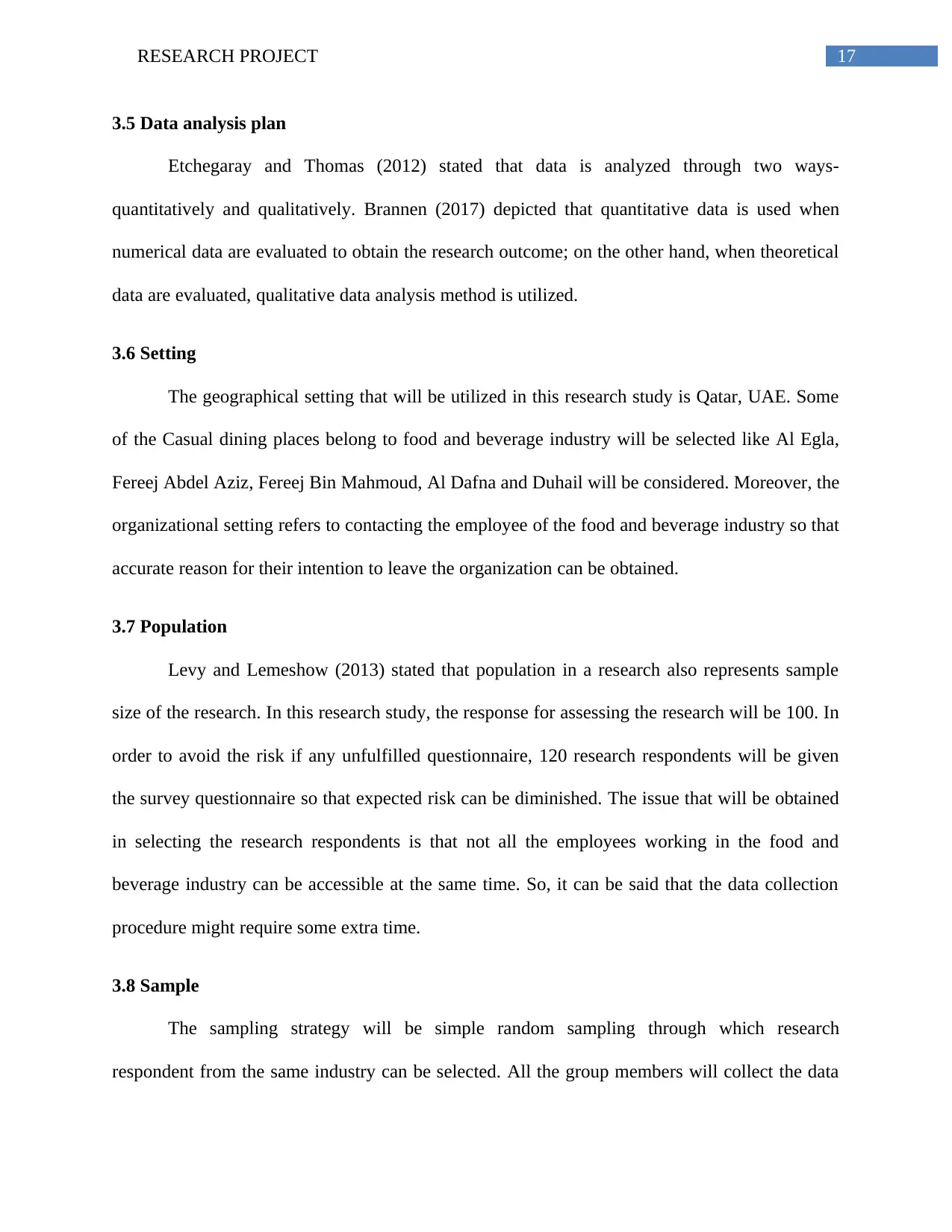
17RESEARCH PROJECT
3.5 Data analysis plan
Etchegaray and Thomas (2012) stated that data is analyzed through two ways-
quantitatively and qualitatively. Brannen (2017) depicted that quantitative data is used when
numerical data are evaluated to obtain the research outcome; on the other hand, when theoretical
data are evaluated, qualitative data analysis method is utilized.
3.6 Setting
The geographical setting that will be utilized in this research study is Qatar, UAE. Some
of the Casual dining places belong to food and beverage industry will be selected like Al Egla,
Fereej Abdel Aziz, Fereej Bin Mahmoud, Al Dafna and Duhail will be considered. Moreover, the
organizational setting refers to contacting the employee of the food and beverage industry so that
accurate reason for their intention to leave the organization can be obtained.
3.7 Population
Levy and Lemeshow (2013) stated that population in a research also represents sample
size of the research. In this research study, the response for assessing the research will be 100. In
order to avoid the risk if any unfulfilled questionnaire, 120 research respondents will be given
the survey questionnaire so that expected risk can be diminished. The issue that will be obtained
in selecting the research respondents is that not all the employees working in the food and
beverage industry can be accessible at the same time. So, it can be said that the data collection
procedure might require some extra time.
3.8 Sample
The sampling strategy will be simple random sampling through which research
respondent from the same industry can be selected. All the group members will collect the data
3.5 Data analysis plan
Etchegaray and Thomas (2012) stated that data is analyzed through two ways-
quantitatively and qualitatively. Brannen (2017) depicted that quantitative data is used when
numerical data are evaluated to obtain the research outcome; on the other hand, when theoretical
data are evaluated, qualitative data analysis method is utilized.
3.6 Setting
The geographical setting that will be utilized in this research study is Qatar, UAE. Some
of the Casual dining places belong to food and beverage industry will be selected like Al Egla,
Fereej Abdel Aziz, Fereej Bin Mahmoud, Al Dafna and Duhail will be considered. Moreover, the
organizational setting refers to contacting the employee of the food and beverage industry so that
accurate reason for their intention to leave the organization can be obtained.
3.7 Population
Levy and Lemeshow (2013) stated that population in a research also represents sample
size of the research. In this research study, the response for assessing the research will be 100. In
order to avoid the risk if any unfulfilled questionnaire, 120 research respondents will be given
the survey questionnaire so that expected risk can be diminished. The issue that will be obtained
in selecting the research respondents is that not all the employees working in the food and
beverage industry can be accessible at the same time. So, it can be said that the data collection
procedure might require some extra time.
3.8 Sample
The sampling strategy will be simple random sampling through which research
respondent from the same industry can be selected. All the group members will collect the data
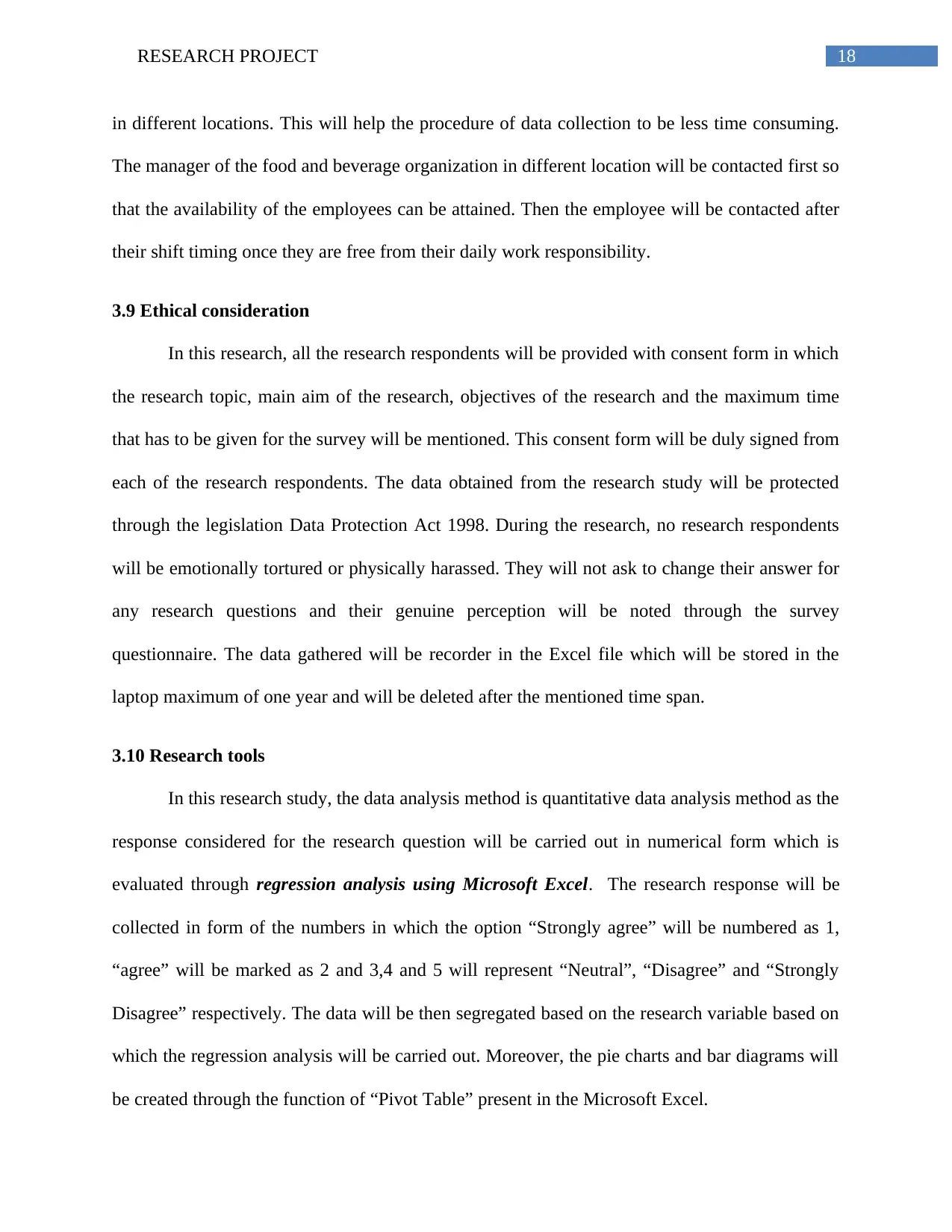
18RESEARCH PROJECT
in different locations. This will help the procedure of data collection to be less time consuming.
The manager of the food and beverage organization in different location will be contacted first so
that the availability of the employees can be attained. Then the employee will be contacted after
their shift timing once they are free from their daily work responsibility.
3.9 Ethical consideration
In this research, all the research respondents will be provided with consent form in which
the research topic, main aim of the research, objectives of the research and the maximum time
that has to be given for the survey will be mentioned. This consent form will be duly signed from
each of the research respondents. The data obtained from the research study will be protected
through the legislation Data Protection Act 1998. During the research, no research respondents
will be emotionally tortured or physically harassed. They will not ask to change their answer for
any research questions and their genuine perception will be noted through the survey
questionnaire. The data gathered will be recorder in the Excel file which will be stored in the
laptop maximum of one year and will be deleted after the mentioned time span.
3.10 Research tools
In this research study, the data analysis method is quantitative data analysis method as the
response considered for the research question will be carried out in numerical form which is
evaluated through regression analysis using Microsoft Excel. The research response will be
collected in form of the numbers in which the option “Strongly agree” will be numbered as 1,
“agree” will be marked as 2 and 3,4 and 5 will represent “Neutral”, “Disagree” and “Strongly
Disagree” respectively. The data will be then segregated based on the research variable based on
which the regression analysis will be carried out. Moreover, the pie charts and bar diagrams will
be created through the function of “Pivot Table” present in the Microsoft Excel.
in different locations. This will help the procedure of data collection to be less time consuming.
The manager of the food and beverage organization in different location will be contacted first so
that the availability of the employees can be attained. Then the employee will be contacted after
their shift timing once they are free from their daily work responsibility.
3.9 Ethical consideration
In this research, all the research respondents will be provided with consent form in which
the research topic, main aim of the research, objectives of the research and the maximum time
that has to be given for the survey will be mentioned. This consent form will be duly signed from
each of the research respondents. The data obtained from the research study will be protected
through the legislation Data Protection Act 1998. During the research, no research respondents
will be emotionally tortured or physically harassed. They will not ask to change their answer for
any research questions and their genuine perception will be noted through the survey
questionnaire. The data gathered will be recorder in the Excel file which will be stored in the
laptop maximum of one year and will be deleted after the mentioned time span.
3.10 Research tools
In this research study, the data analysis method is quantitative data analysis method as the
response considered for the research question will be carried out in numerical form which is
evaluated through regression analysis using Microsoft Excel. The research response will be
collected in form of the numbers in which the option “Strongly agree” will be numbered as 1,
“agree” will be marked as 2 and 3,4 and 5 will represent “Neutral”, “Disagree” and “Strongly
Disagree” respectively. The data will be then segregated based on the research variable based on
which the regression analysis will be carried out. Moreover, the pie charts and bar diagrams will
be created through the function of “Pivot Table” present in the Microsoft Excel.
Paraphrase This Document
Need a fresh take? Get an instant paraphrase of this document with our AI Paraphraser
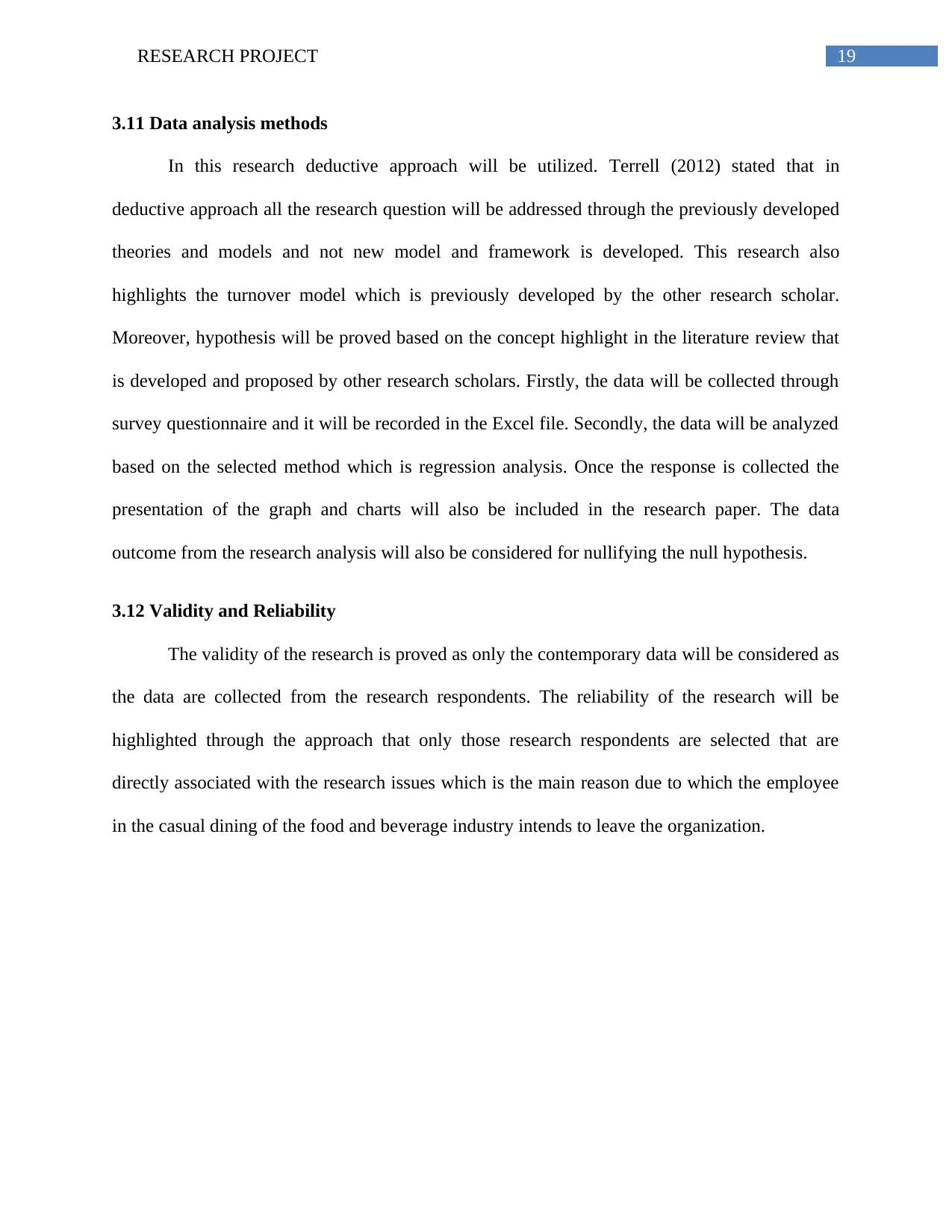
19RESEARCH PROJECT
3.11 Data analysis methods
In this research deductive approach will be utilized. Terrell (2012) stated that in
deductive approach all the research question will be addressed through the previously developed
theories and models and not new model and framework is developed. This research also
highlights the turnover model which is previously developed by the other research scholar.
Moreover, hypothesis will be proved based on the concept highlight in the literature review that
is developed and proposed by other research scholars. Firstly, the data will be collected through
survey questionnaire and it will be recorded in the Excel file. Secondly, the data will be analyzed
based on the selected method which is regression analysis. Once the response is collected the
presentation of the graph and charts will also be included in the research paper. The data
outcome from the research analysis will also be considered for nullifying the null hypothesis.
3.12 Validity and Reliability
The validity of the research is proved as only the contemporary data will be considered as
the data are collected from the research respondents. The reliability of the research will be
highlighted through the approach that only those research respondents are selected that are
directly associated with the research issues which is the main reason due to which the employee
in the casual dining of the food and beverage industry intends to leave the organization.
3.11 Data analysis methods
In this research deductive approach will be utilized. Terrell (2012) stated that in
deductive approach all the research question will be addressed through the previously developed
theories and models and not new model and framework is developed. This research also
highlights the turnover model which is previously developed by the other research scholar.
Moreover, hypothesis will be proved based on the concept highlight in the literature review that
is developed and proposed by other research scholars. Firstly, the data will be collected through
survey questionnaire and it will be recorded in the Excel file. Secondly, the data will be analyzed
based on the selected method which is regression analysis. Once the response is collected the
presentation of the graph and charts will also be included in the research paper. The data
outcome from the research analysis will also be considered for nullifying the null hypothesis.
3.12 Validity and Reliability
The validity of the research is proved as only the contemporary data will be considered as
the data are collected from the research respondents. The reliability of the research will be
highlighted through the approach that only those research respondents are selected that are
directly associated with the research issues which is the main reason due to which the employee
in the casual dining of the food and beverage industry intends to leave the organization.
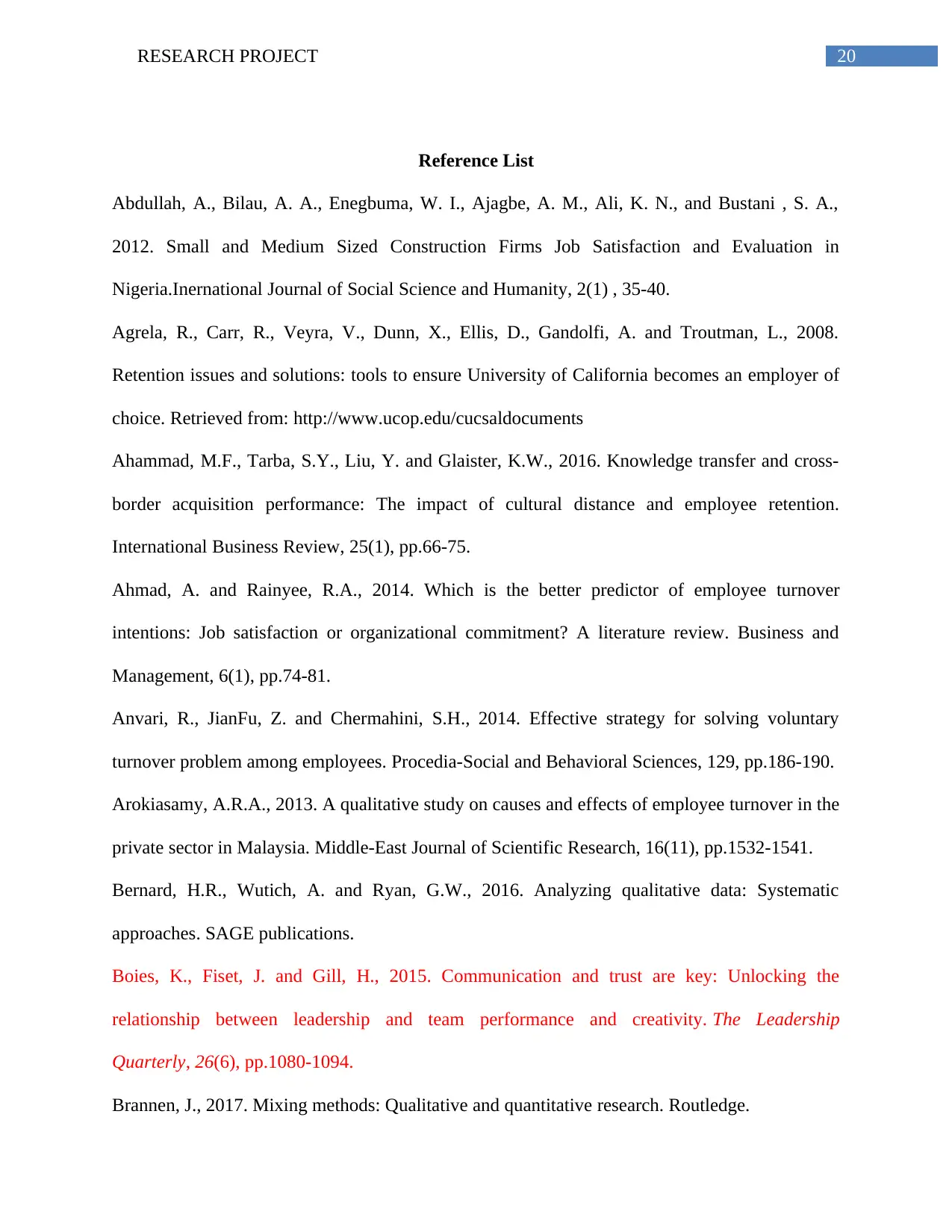
20RESEARCH PROJECT
Reference List
Abdullah, A., Bilau, A. A., Enegbuma, W. I., Ajagbe, A. M., Ali, K. N., and Bustani , S. A.,
2012. Small and Medium Sized Construction Firms Job Satisfaction and Evaluation in
Nigeria.Inernational Journal of Social Science and Humanity, 2(1) , 35-40.
Agrela, R., Carr, R., Veyra, V., Dunn, X., Ellis, D., Gandolfi, A. and Troutman, L., 2008.
Retention issues and solutions: tools to ensure University of California becomes an employer of
choice. Retrieved from: http://www.ucop.edu/cucsaldocuments
Ahammad, M.F., Tarba, S.Y., Liu, Y. and Glaister, K.W., 2016. Knowledge transfer and cross-
border acquisition performance: The impact of cultural distance and employee retention.
International Business Review, 25(1), pp.66-75.
Ahmad, A. and Rainyee, R.A., 2014. Which is the better predictor of employee turnover
intentions: Job satisfaction or organizational commitment? A literature review. Business and
Management, 6(1), pp.74-81.
Anvari, R., JianFu, Z. and Chermahini, S.H., 2014. Effective strategy for solving voluntary
turnover problem among employees. Procedia-Social and Behavioral Sciences, 129, pp.186-190.
Arokiasamy, A.R.A., 2013. A qualitative study on causes and effects of employee turnover in the
private sector in Malaysia. Middle-East Journal of Scientific Research, 16(11), pp.1532-1541.
Bernard, H.R., Wutich, A. and Ryan, G.W., 2016. Analyzing qualitative data: Systematic
approaches. SAGE publications.
Boies, K., Fiset, J. and Gill, H., 2015. Communication and trust are key: Unlocking the
relationship between leadership and team performance and creativity. The Leadership
Quarterly, 26(6), pp.1080-1094.
Brannen, J., 2017. Mixing methods: Qualitative and quantitative research. Routledge.
Reference List
Abdullah, A., Bilau, A. A., Enegbuma, W. I., Ajagbe, A. M., Ali, K. N., and Bustani , S. A.,
2012. Small and Medium Sized Construction Firms Job Satisfaction and Evaluation in
Nigeria.Inernational Journal of Social Science and Humanity, 2(1) , 35-40.
Agrela, R., Carr, R., Veyra, V., Dunn, X., Ellis, D., Gandolfi, A. and Troutman, L., 2008.
Retention issues and solutions: tools to ensure University of California becomes an employer of
choice. Retrieved from: http://www.ucop.edu/cucsaldocuments
Ahammad, M.F., Tarba, S.Y., Liu, Y. and Glaister, K.W., 2016. Knowledge transfer and cross-
border acquisition performance: The impact of cultural distance and employee retention.
International Business Review, 25(1), pp.66-75.
Ahmad, A. and Rainyee, R.A., 2014. Which is the better predictor of employee turnover
intentions: Job satisfaction or organizational commitment? A literature review. Business and
Management, 6(1), pp.74-81.
Anvari, R., JianFu, Z. and Chermahini, S.H., 2014. Effective strategy for solving voluntary
turnover problem among employees. Procedia-Social and Behavioral Sciences, 129, pp.186-190.
Arokiasamy, A.R.A., 2013. A qualitative study on causes and effects of employee turnover in the
private sector in Malaysia. Middle-East Journal of Scientific Research, 16(11), pp.1532-1541.
Bernard, H.R., Wutich, A. and Ryan, G.W., 2016. Analyzing qualitative data: Systematic
approaches. SAGE publications.
Boies, K., Fiset, J. and Gill, H., 2015. Communication and trust are key: Unlocking the
relationship between leadership and team performance and creativity. The Leadership
Quarterly, 26(6), pp.1080-1094.
Brannen, J., 2017. Mixing methods: Qualitative and quantitative research. Routledge.
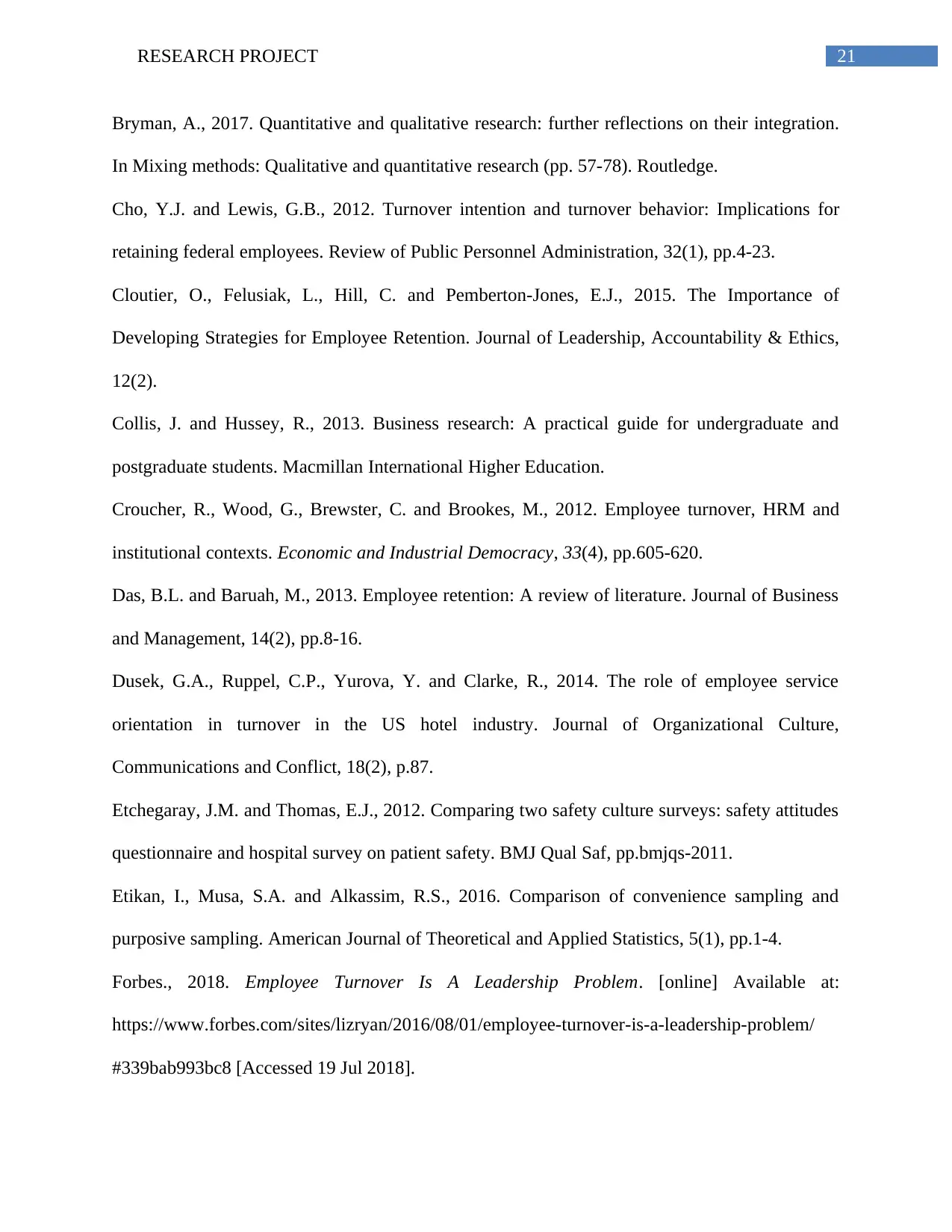
21RESEARCH PROJECT
Bryman, A., 2017. Quantitative and qualitative research: further reflections on their integration.
In Mixing methods: Qualitative and quantitative research (pp. 57-78). Routledge.
Cho, Y.J. and Lewis, G.B., 2012. Turnover intention and turnover behavior: Implications for
retaining federal employees. Review of Public Personnel Administration, 32(1), pp.4-23.
Cloutier, O., Felusiak, L., Hill, C. and Pemberton-Jones, E.J., 2015. The Importance of
Developing Strategies for Employee Retention. Journal of Leadership, Accountability & Ethics,
12(2).
Collis, J. and Hussey, R., 2013. Business research: A practical guide for undergraduate and
postgraduate students. Macmillan International Higher Education.
Croucher, R., Wood, G., Brewster, C. and Brookes, M., 2012. Employee turnover, HRM and
institutional contexts. Economic and Industrial Democracy, 33(4), pp.605-620.
Das, B.L. and Baruah, M., 2013. Employee retention: A review of literature. Journal of Business
and Management, 14(2), pp.8-16.
Dusek, G.A., Ruppel, C.P., Yurova, Y. and Clarke, R., 2014. The role of employee service
orientation in turnover in the US hotel industry. Journal of Organizational Culture,
Communications and Conflict, 18(2), p.87.
Etchegaray, J.M. and Thomas, E.J., 2012. Comparing two safety culture surveys: safety attitudes
questionnaire and hospital survey on patient safety. BMJ Qual Saf, pp.bmjqs-2011.
Etikan, I., Musa, S.A. and Alkassim, R.S., 2016. Comparison of convenience sampling and
purposive sampling. American Journal of Theoretical and Applied Statistics, 5(1), pp.1-4.
Forbes., 2018. Employee Turnover Is A Leadership Problem. [online] Available at:
https://www.forbes.com/sites/lizryan/2016/08/01/employee-turnover-is-a-leadership-problem/
#339bab993bc8 [Accessed 19 Jul 2018].
Bryman, A., 2017. Quantitative and qualitative research: further reflections on their integration.
In Mixing methods: Qualitative and quantitative research (pp. 57-78). Routledge.
Cho, Y.J. and Lewis, G.B., 2012. Turnover intention and turnover behavior: Implications for
retaining federal employees. Review of Public Personnel Administration, 32(1), pp.4-23.
Cloutier, O., Felusiak, L., Hill, C. and Pemberton-Jones, E.J., 2015. The Importance of
Developing Strategies for Employee Retention. Journal of Leadership, Accountability & Ethics,
12(2).
Collis, J. and Hussey, R., 2013. Business research: A practical guide for undergraduate and
postgraduate students. Macmillan International Higher Education.
Croucher, R., Wood, G., Brewster, C. and Brookes, M., 2012. Employee turnover, HRM and
institutional contexts. Economic and Industrial Democracy, 33(4), pp.605-620.
Das, B.L. and Baruah, M., 2013. Employee retention: A review of literature. Journal of Business
and Management, 14(2), pp.8-16.
Dusek, G.A., Ruppel, C.P., Yurova, Y. and Clarke, R., 2014. The role of employee service
orientation in turnover in the US hotel industry. Journal of Organizational Culture,
Communications and Conflict, 18(2), p.87.
Etchegaray, J.M. and Thomas, E.J., 2012. Comparing two safety culture surveys: safety attitudes
questionnaire and hospital survey on patient safety. BMJ Qual Saf, pp.bmjqs-2011.
Etikan, I., Musa, S.A. and Alkassim, R.S., 2016. Comparison of convenience sampling and
purposive sampling. American Journal of Theoretical and Applied Statistics, 5(1), pp.1-4.
Forbes., 2018. Employee Turnover Is A Leadership Problem. [online] Available at:
https://www.forbes.com/sites/lizryan/2016/08/01/employee-turnover-is-a-leadership-problem/
#339bab993bc8 [Accessed 19 Jul 2018].
Secure Best Marks with AI Grader
Need help grading? Try our AI Grader for instant feedback on your assignments.
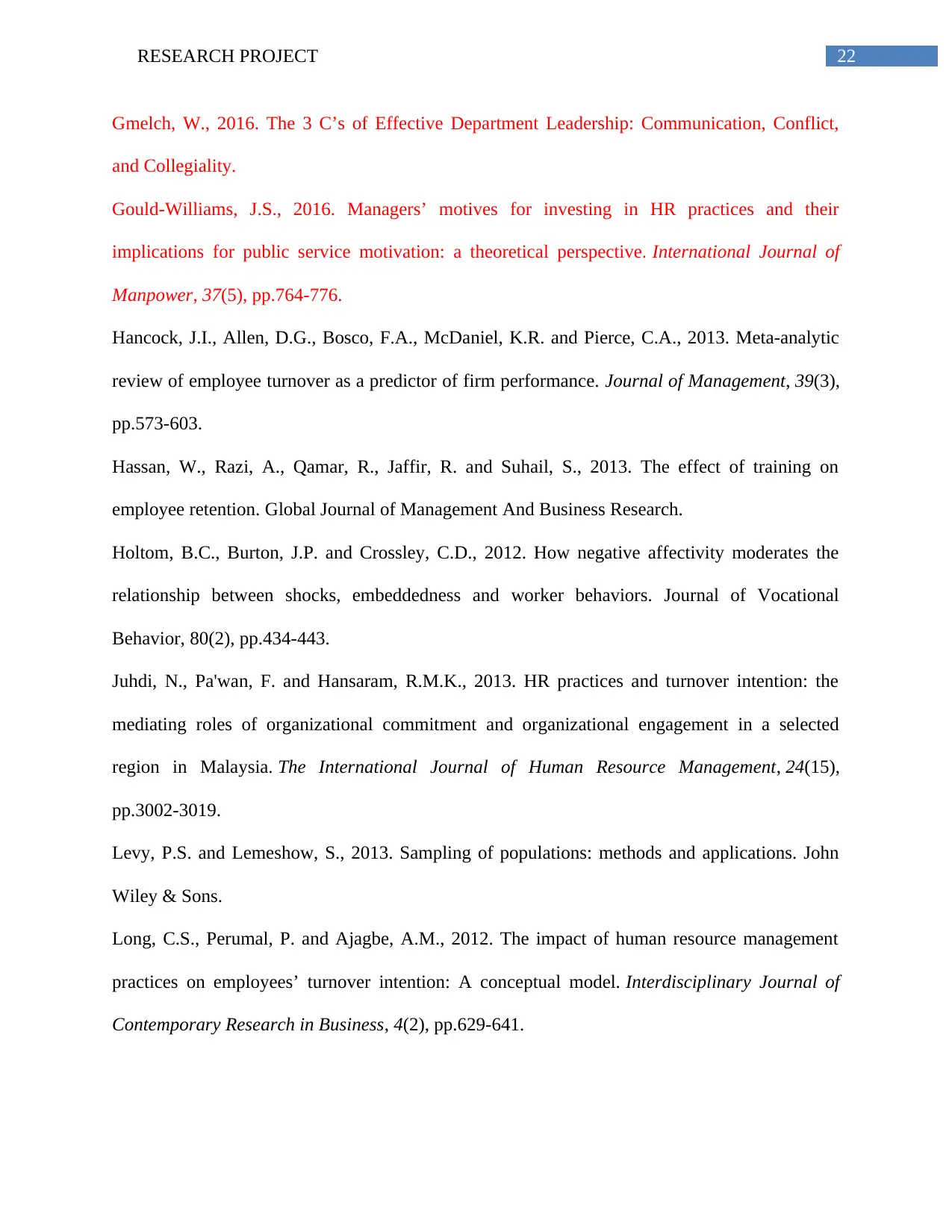
22RESEARCH PROJECT
Gmelch, W., 2016. The 3 C’s of Effective Department Leadership: Communication, Conflict,
and Collegiality.
Gould-Williams, J.S., 2016. Managers’ motives for investing in HR practices and their
implications for public service motivation: a theoretical perspective. International Journal of
Manpower, 37(5), pp.764-776.
Hancock, J.I., Allen, D.G., Bosco, F.A., McDaniel, K.R. and Pierce, C.A., 2013. Meta-analytic
review of employee turnover as a predictor of firm performance. Journal of Management, 39(3),
pp.573-603.
Hassan, W., Razi, A., Qamar, R., Jaffir, R. and Suhail, S., 2013. The effect of training on
employee retention. Global Journal of Management And Business Research.
Holtom, B.C., Burton, J.P. and Crossley, C.D., 2012. How negative affectivity moderates the
relationship between shocks, embeddedness and worker behaviors. Journal of Vocational
Behavior, 80(2), pp.434-443.
Juhdi, N., Pa'wan, F. and Hansaram, R.M.K., 2013. HR practices and turnover intention: the
mediating roles of organizational commitment and organizational engagement in a selected
region in Malaysia. The International Journal of Human Resource Management, 24(15),
pp.3002-3019.
Levy, P.S. and Lemeshow, S., 2013. Sampling of populations: methods and applications. John
Wiley & Sons.
Long, C.S., Perumal, P. and Ajagbe, A.M., 2012. The impact of human resource management
practices on employees’ turnover intention: A conceptual model. Interdisciplinary Journal of
Contemporary Research in Business, 4(2), pp.629-641.
Gmelch, W., 2016. The 3 C’s of Effective Department Leadership: Communication, Conflict,
and Collegiality.
Gould-Williams, J.S., 2016. Managers’ motives for investing in HR practices and their
implications for public service motivation: a theoretical perspective. International Journal of
Manpower, 37(5), pp.764-776.
Hancock, J.I., Allen, D.G., Bosco, F.A., McDaniel, K.R. and Pierce, C.A., 2013. Meta-analytic
review of employee turnover as a predictor of firm performance. Journal of Management, 39(3),
pp.573-603.
Hassan, W., Razi, A., Qamar, R., Jaffir, R. and Suhail, S., 2013. The effect of training on
employee retention. Global Journal of Management And Business Research.
Holtom, B.C., Burton, J.P. and Crossley, C.D., 2012. How negative affectivity moderates the
relationship between shocks, embeddedness and worker behaviors. Journal of Vocational
Behavior, 80(2), pp.434-443.
Juhdi, N., Pa'wan, F. and Hansaram, R.M.K., 2013. HR practices and turnover intention: the
mediating roles of organizational commitment and organizational engagement in a selected
region in Malaysia. The International Journal of Human Resource Management, 24(15),
pp.3002-3019.
Levy, P.S. and Lemeshow, S., 2013. Sampling of populations: methods and applications. John
Wiley & Sons.
Long, C.S., Perumal, P. and Ajagbe, A.M., 2012. The impact of human resource management
practices on employees’ turnover intention: A conceptual model. Interdisciplinary Journal of
Contemporary Research in Business, 4(2), pp.629-641.
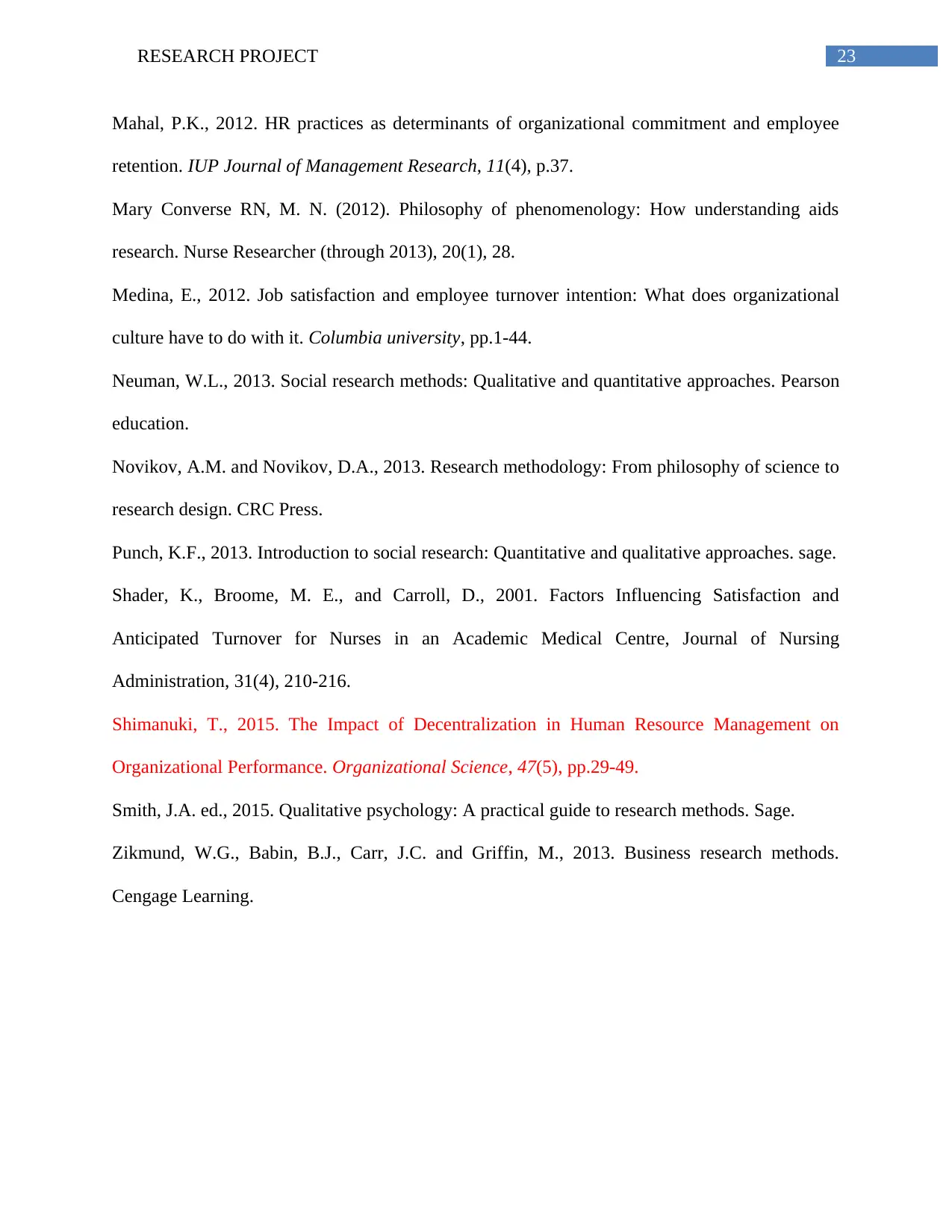
23RESEARCH PROJECT
Mahal, P.K., 2012. HR practices as determinants of organizational commitment and employee
retention. IUP Journal of Management Research, 11(4), p.37.
Mary Converse RN, M. N. (2012). Philosophy of phenomenology: How understanding aids
research. Nurse Researcher (through 2013), 20(1), 28.
Medina, E., 2012. Job satisfaction and employee turnover intention: What does organizational
culture have to do with it. Columbia university, pp.1-44.
Neuman, W.L., 2013. Social research methods: Qualitative and quantitative approaches. Pearson
education.
Novikov, A.M. and Novikov, D.A., 2013. Research methodology: From philosophy of science to
research design. CRC Press.
Punch, K.F., 2013. Introduction to social research: Quantitative and qualitative approaches. sage.
Shader, K., Broome, M. E., and Carroll, D., 2001. Factors Influencing Satisfaction and
Anticipated Turnover for Nurses in an Academic Medical Centre, Journal of Nursing
Administration, 31(4), 210-216.
Shimanuki, T., 2015. The Impact of Decentralization in Human Resource Management on
Organizational Performance. Organizational Science, 47(5), pp.29-49.
Smith, J.A. ed., 2015. Qualitative psychology: A practical guide to research methods. Sage.
Zikmund, W.G., Babin, B.J., Carr, J.C. and Griffin, M., 2013. Business research methods.
Cengage Learning.
Mahal, P.K., 2012. HR practices as determinants of organizational commitment and employee
retention. IUP Journal of Management Research, 11(4), p.37.
Mary Converse RN, M. N. (2012). Philosophy of phenomenology: How understanding aids
research. Nurse Researcher (through 2013), 20(1), 28.
Medina, E., 2012. Job satisfaction and employee turnover intention: What does organizational
culture have to do with it. Columbia university, pp.1-44.
Neuman, W.L., 2013. Social research methods: Qualitative and quantitative approaches. Pearson
education.
Novikov, A.M. and Novikov, D.A., 2013. Research methodology: From philosophy of science to
research design. CRC Press.
Punch, K.F., 2013. Introduction to social research: Quantitative and qualitative approaches. sage.
Shader, K., Broome, M. E., and Carroll, D., 2001. Factors Influencing Satisfaction and
Anticipated Turnover for Nurses in an Academic Medical Centre, Journal of Nursing
Administration, 31(4), 210-216.
Shimanuki, T., 2015. The Impact of Decentralization in Human Resource Management on
Organizational Performance. Organizational Science, 47(5), pp.29-49.
Smith, J.A. ed., 2015. Qualitative psychology: A practical guide to research methods. Sage.
Zikmund, W.G., Babin, B.J., Carr, J.C. and Griffin, M., 2013. Business research methods.
Cengage Learning.
1 out of 24
Related Documents
Your All-in-One AI-Powered Toolkit for Academic Success.
+13062052269
info@desklib.com
Available 24*7 on WhatsApp / Email
![[object Object]](/_next/static/media/star-bottom.7253800d.svg)
Unlock your academic potential
© 2024 | Zucol Services PVT LTD | All rights reserved.




